Boeing B-52 Stratofortress
| B-52 Stratofortress | |
|---|---|
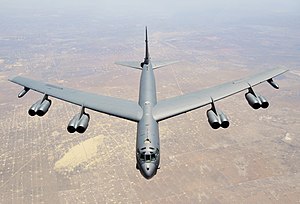 A B-52H fromBarksdale AFBflying over Texas | |
| General information | |
| Type | Strategicheavy bomber |
| National origin | United States |
| Manufacturer | Boeing |
| Primary users | United States Air Force NASA(historical) |
| Number built | 744[1] |
| History | |
| Manufactured | 1952–1962 |
| Introduction date | February 1955 |
| First flight | 15 April 1952 |
| In service | 1952–present |
TheBoeing B-52 Stratofortressis an American long-range,subsonic,jet-poweredstrategic bomber.The B-52 was designed and built byBoeing,which has continued to provide support and upgrades. It has been operated by theUnited States Air Force(USAF) since the 1950s, and NASA for over 50 years. The bomber can carry up to 70,000 pounds (32,000 kg) of weapons[2]and has a typicalcombat rangeof around 8,800 miles (14,200 km) withoutaerial refueling.[3]
Beginning with the successful contract bid in June 1946, the B-52 design evolved from astraight wingaircraft powered by sixturbopropengines to the final prototype YB-52 with eightturbojetengines andswept wings.The B-52 took itsmaiden flightin April 1952. The B-52 has been in service with the USAF since 1955, and NASA from 1959 to 2007.[4]Built to carrynuclear weaponsforCold War–eradeterrencemissions, the B-52 Stratofortress replaced theConvair B-36 Peacemaker.
Superior performance at high subsonic speeds and relatively low operating costs have kept them in service despite the development of more advanced strategic bombers, such as the Mach 2+Convair B-58 Hustler,the canceled Mach 3North American XB-70 Valkyrie,thevariable-geometryRockwell B-1 Lancer,and the stealthNorthrop Grumman B-2 Spirit.A veteran of several wars, the B-52 has dropped onlyconventional munitionsin combat.
The B-52's official nameStratofortressis rarely used; informally, the aircraft has become commonly referred to as theBUFF(Big Ugly Fat Fucker/Fella).[5][6][7][Note 1] There are 76 aircraft in inventory as of 2024[update];[9]58 operated by active forces (2nd Bomb Wingand5th Bomb Wing), 18 by reserve forces (307th Bomb Wing), and about 12 in long-term storage at theDavis-Monthan AFB Boneyard.[2][3][10][11][12]The bombers flew under theStrategic Air Command(SAC) until it was disestablished in 1992 and its aircraft absorbed into theAir Combat Command(ACC); in 2010, all B-52 Stratofortresses were transferred from the ACC to the newAir Force Global Strike Command(AFGSC). The B-52 completed 60 years of continuous service with its original operator in 2015. After being upgraded between 2013 and 2015, the last airplanes are expected to serve into the 2050s.
Development
[edit]Origins
[edit]On 23 November 1945,Air Materiel Command(AMC) issued desired performance characteristics for a new strategic bomber "capable of carrying out the strategic mission without dependence upon advanced and intermediate bases controlled by other countries".[14]The aircraft was to have a crew of five or moreturret gunners,and a six-man relief crew. It was required tocruiseat 300 miles per hour (260 kn; 480 km/h) at 34,000 feet (10,000 m) with a combat radius of 5,000 miles (4,300 nmi; 8,000 km). The armament was to consist of an unspecified number of 20 mm cannons and 10,000 pounds (4,500 kg) of bombs.[15]On 13 February 1946, theUSAAFissued bid invitations for these specifications, with Boeing,Consolidated Aircraft,andGlenn L. Martin Companysubmitting proposals.[15]
On 5 June 1946, Boeing's Model 462, a straight-wing aircraft powered by sixWright T35turbopropswith a gross weight of 360,000 pounds (160,000 kg) and a combat radius of 3,110 miles (2,700 nmi; 5,010 km), was declared the winner.[16]On 28 June 1946, Boeing was issued a letter of contract forUS$1.7million to build a full-scalemockupof the new XB-52 and do preliminary engineering and testing.[17]However, by October 1946, the USAAF began to express concern about the sheer size of the new aircraft and its inability to meet the specified design requirements.[18]In response, Boeing produced the Model 464, a smaller four-engine version with a 230,000-pound (100,000 kg) gross weight, which was briefly deemed acceptable.[19]
Subsequently, in November 1946, the Deputy Chief of Air Staff for Research and Development, GeneralCurtis LeMay,expressed the desire for a cruising speed of 400 miles per hour (350 kn; 640 km/h), to which Boeing responded with a 300,000-pound (140,000 kg) aircraft.[20]In December 1946, Boeing was asked to change their design to a four-engine bomber with a top speed of 400 miles per hour (350 kn; 640 km/h), range of 12,000 miles (10,000 nmi; 19,000 km), and the ability to carry anuclear weapon;in total, the aircraft could weigh up to 480,000 pounds (220,000 kg).[21]Boeing responded with two models powered by T35 turboprops. The Model 464-16 was a "nuclear only" bomber with a 10,000-pound (4,500 kg) payload, while the Model 464-17 was a general purpose bomber with a 9,000-pound (4,100 kg) payload.[21]Due to the cost associated with purchasing two specialized aircraft, the USAAF selected Model 464-17 with the understanding that it could be adapted for nuclear strikes.[22]
In June 1947, the military requirements were updated and the Model 464-17 met all of them except for the range.[23]It was becoming obvious to the USAAF that, even with the updated performance, the XB-52 would be obsolete by the time it entered production and would offer little improvement over theConvair B-36 Peacemaker;as a result, the entire project was postponed for six months.[24]During this time, Boeing continued to perfect the design, which resulted in the Model 464-29 with a top speed of 455 miles per hour (395 kn; 732 km/h) and a 5,000-mile (8,000 km) range.[25]In September 1947, the Heavy Bombardment Committee was convened to ascertain performance requirements for a nuclear bomber. Formalized on 8 December 1947, these requirements called for a top speed of 500 miles per hour (430 kn; 800 km/h) and an 8,000-mile (7,000 nmi; 13,000 km) range, far beyond the capabilities of the 464-29.[26]
The outright cancellation of the Boeing contract on 11 December 1947 was staved off by a plea from its presidentWilliam McPherson Allento the Secretary of the Air ForceStuart Symington.[27]Allen reasoned that the design was capable of being adapted to new aviation technology and more stringent requirements.[28]In January 1948, Boeing was instructed to thoroughly explore recent technological innovations, includingaerial refuelingand theflying wing.[29]Noting stability and control problemsNorthrop Corporationwas experiencing with theirYB-35andYB-49flying wing bombers, Boeing insisted on a conventional aircraft, and in April 1948 presented aUS$30million (US$380 million today[30]) proposal for design, construction, and testing of two Model 464-35 prototypes.[31]Further revisions during 1948 resulted in an aircraft with a top speed of 513 miles per hour (446 kn; 826 km/h) at 35,000 feet (11,000 m), a range of 6,909 miles (6,004 nmi; 11,119 km), and a 280,000-pound (130,000 kg) gross weight, which included 10,000 pounds (4,500 kg) of bombs and 19,875 US gallons (75,240 L) of fuel.[32]
Design effort
[edit]

In May 1948, Air Materiel Command asked Boeing to incorporate the previously discarded jet engine, with improvements infuel efficiency,into the design.[33]That resulted in the development of yet another revision—in July 1948, Model 464-40 substitutedWestinghouse J40turbojetsfor the turboprops.[34]The USAF project officer who reviewed the Model 464-40 was favorably impressed, especially since he had already been thinking along similar lines. Nevertheless, the government was concerned about the high fuel consumption rate of the jet engines of the day, and directed Boeing to use the turboprop-powered Model 464-35 as the basis for the XB-52. Although he agreed that turbojet propulsion was the future, General Howard A. Craig, Deputy Chief of Staff for Materiel, was not very enthusiastic about a jet-powered B-52 since he felt that the jet engine had not yet progressed sufficiently to permit skipping an intermediate turboprop stage. However, Boeing was encouraged to continue turbojet studies even without any expected commitment to jet propulsion.[35][36]
On Thursday, 21 October 1948, Boeing engineersGeorge S. Schairer,Art Carlsen, and Vaughn Blumenthal presented the design of a four-engine turboprop bomber to the chief of bomber development, ColonelPete Warden.Warden was disappointed by the projected aircraft and asked if the Boeing team could produce a proposal for a four-engine turbojet bomber. Joined by Ed Wells, Boeing's vice president of engineering, the engineers worked that night inThe Hotel Van Clevein Dayton, Ohio, redesigning Boeing's proposal as a four-engine turbojet bomber. On Friday, Colonel Warden looked over the information and asked for a better design. Returning to the hotel, the Boeing team was joined by Bob Withington and Maynard Pennell, two top Boeing engineers who were in town on other business.[37]
By late Friday night, they had laid out what was an essentially new airplane. The new design (464-49) built upon the basic layout of theB-47 Stratojetwith 35-degreeswept wings,eight engines paired in four underwingpods,and bicycle landing gear with wingtip outrigger wheels.[38]A notable feature was the ability to pivot both fore and aft main landing gear up to 20° from the aircraft centerline to increase safety duringcrosswind landings(allowing the aircraft to "crab" or roll with a sideways slip angle down the runway).[39]After a trip to a hobby shop for supplies, Schairer set to work building a model. The rest of the team focused on weight and performance data. Wells, who was also a skilled artist, completed the aircraft drawings. On Sunday, a stenographer was hired to type a clean copy of the proposal. On Monday, Schairer presented Colonel Warden with a neatly bound 33-page proposal and a 14-inch (36 cm) scale model.[40][41]The aircraft was projected to exceed all design specifications.[42]

Although the full-size mock-up inspection in April 1949 was generally favorable, range again became a concern since the J40s and early model J57s had excessive fuel consumption.[43]Despite talk of another revision of specifications or even a full design competition among aircraft manufacturers, General LeMay, now in charge of Strategic Air Command, insisted that performance should not be compromised due to delays in engine development.[44]In a final attempt to increase range, Boeing created the larger 464-67, stating that once in production, the range could be further increased in subsequent modifications.[45]Following several direct interventions by LeMay,[46]Boeing was awarded a production contract for thirteen B-52As and seventeen detachable reconnaissance pods on 14 February 1951.[47]The last major design change—also at General LeMay's insistence—was a switch from the B-47 style tandem seating to a more conventional side-by-side cockpit, which increased the effectiveness of the copilot and reduced crew fatigue.[48]Both XB-52 prototypes featured the original tandem seating arrangement with a framed bubble-type canopy (see above images).[49]
Tex Johnston noted, "The B-52, like the B-47, utilized a flexible wing. I saw the wingtip of the B-52 static test airplane travel 32 feet (9.8 m), from the negative 1-G load position to the positive 4-G load position." The flexible structure allowed "...the wing to flex during gust and maneuvering loads, thus relieving high-stress areas and providing a smoother ride." During a 3.5-G pullup, "The wingtips appeared about 35 degrees above level flight position."[50]
Pre-production and production
[edit]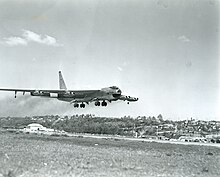
During ground testing on 29 November 1951, the XB-52's pneumatic system failed during a full-pressure test; the resulting explosion severely damaged the trailing edge of the wing, necessitating considerable repairs. The YB-52, the second XB-52 modified with more operational equipment,first flewon 15 April 1952 with"Tex" Johnstonas the pilot.[51][52]A 2-hour, 21-minute proving flight fromBoeing Field,nearSeattle,Washington, toLarson Air Force Basewas undertaken with Boeing test pilot Johnston and USAF Lieutenant ColonelGuy M. Townsend.[53]The XB-52 followed on 2 October 1952.[54]The thorough development,[Note 2]including 670 days in thewind tunneland 130 days ofaerodynamicandaeroelastictesting, paid off with smooth flight testing. Encouraged, the USAF increased its order to 282 B-52s.[56]
| Fiscal year |
B-52 model | Total | ||||||||
|---|---|---|---|---|---|---|---|---|---|---|
| A [57] |
B [58] |
C [59] |
D [60] |
E [61] |
F [62] |
G [63] |
H [64] |
Annual | Cumulative | |
| 1954 | 3 | 3 | 3 | |||||||
| 1955 | 13 | 13 | 16 | |||||||
| 1956 | 35 | 5 | 1 | 41 | 57 | |||||
| 1957 | 2 | 30 | 92 | 124 | 181 | |||||
| 1958 | 77 | 100 | 10 | 187 | 368 | |||||
| 1959 | 79 | 50 | 129 | 497 | ||||||
| 1960 | 106 | 106 | 603 | |||||||
| 1961 | 37 | 20 | 57 | 660 | ||||||
| 1962 | 68 | 68 | 728 | |||||||
| 1963 | 14 | 14 | 742 | |||||||
| Total | 3 | 50 | 35 | 170 | 100 | 89 | 193 | 102 | 742 | 742 |
Only three of the 13 B-52As ordered were built.[65]All were returned to Boeing and used in their test program.[57]On 9 June 1952, the February 1951 contract was updated to order the aircraft under new specifications. The final 10, the first aircraft to enter active service, were completed as B-52Bs.[57]At the roll-out ceremony on 18 March 1954, Air Force Chief of Staff GeneralNathan Twiningsaid:
Thelong riflewas the great weapon of its day.... today this B-52 is the long rifle of the air age.[66]
The B-52B was followed by progressively improved bomber and reconnaissance variants, culminating in the B-52G andturbofanB-52H. To allow rapid delivery, production lines were set up both at its main Seattle factory and at Boeing'sWichitafacility. More than 5,000 companies were involved in the huge production effort, with 41% of the airframe being built by subcontractors.[67]The prototypes and all B-52A, B and C models (90 aircraft)[68]were built at Seattle. Testing of aircraft built in Seattle caused problems due to jet noise, which led to the establishment of curfews for engine tests. Aircraft were ferried 150 miles (240 km) east on their maiden flights to Larson Air Force Base nearMoses Lake,where they were fully tested.[69]
As production of the B-47 came to an end, the Wichita factory was phased in for B-52D production, with Seattle responsible for 101 D-models and Wichita 69.[70]Both plants continued to build the B-52E, with 42 built at Seattle and 58 at Wichita,[71]and the B-52F (44 from Seattle and 45 from Wichita).[72]For the B-52G, Boeing decided in 1957 to transfer all production to Wichita, which freed up Seattle for other tasks, in particular, the production of airliners.[73]Production ended in 1962 with the B-52H, with 742 aircraft built, plus the original two prototypes.[74]
Upgrades
[edit]A proposed variant of the B-52H was the EB-52H, which would have consisted of 16 modified and augmented B-52H airframes with additionalelectronic jammingcapabilities.[75][76]This variant would have restored USAF airborne jamming capability that it lost on retiring theEF-111 Raven.The program was canceled in 2005 following the removal of funds for the stand-off jammer. The program was revived in 2007 and cut again in early 2009.[77]
In July 2013, the USAF began a fleet-wide technological upgrade of its B-52 bombers called Combat Network Communications Technology (CONECT) to modernize electronics, communications technology, computing, and avionics on the flight deck. CONECT upgrades include software and hardware such as new computer servers, modems, radios, data-links, receivers, and digital workstations for the crew. One update is theAN/ARC-210Warrior beyond-line-of-sight software programmable radio able to transmit voice, data, and information in-flight between B-52s and ground command and control centers, allowing the transmission and reception of data with updated intelligence, mapping, and targeting information; previous in-flight target changes required copying down coordinates. The ARC-210 allows machine-to-machine transfer of data, useful on long-endurance missions where targets may have moved before the arrival of the B-52. The aircraft will be able to receive information throughLink-16.CONECT upgrades will costUS$1.1billion overall and take several years. Funding has been secured for 30 B-52s; the USAF hopes for 10 CONECT upgrades per year, but the rate has yet to be decided.[78][79]
Weapons upgrades include the 1760 Internal Weapons Bay Upgrade (IWBU), which gives a 66 percent increase in weapons payload using a digital interface (MIL-STD-1760) and rotary launcher. IWBU is expected to cost roughlyUS$313million.[78]The 1760 IWBU will allow the B-52 to carry eight[80]JDAM2,000-pound (910 kg) bombs,AGM-158B JASSM-ERcruise missile and theADM-160C MALD-Jdecoy missiles internally. All 1760 IWBUs should be operational by October 2017. Two bombers will have the ability to carry 40 weapons in place of the 36 that three B-52s can carry.[81]The 1760 IWBU allows precision-guided missiles or bombs to be deployed from inside the weapons bay; the previous aircraft carried these munitions externally on the winghardpoints.This increases the number of guided weapons (Joint Direct Attack Munitionor JDAM) a B-52 can carry and reduces the need for guided bombs to be carried on the wings. The first phase will allow a B-52 to carry twenty-four GBU-38 500-pound guided bombs or twenty GBU-31 2,000-pound bombs, with later phases accommodating the JASSM and MALD family of missiles.[82]In addition to carrying more smart bombs, moving them internally from the wings reduces drag and achieves a 15 percent reduction in fuel consumption.[83]
The US Air Force Research Lab is investigating defensive laser weapons for the B-52.[84]
The B-52 is due to receive a range of upgrades alongside a planned engine retrofit. These upgrades aim to modernize the sensors and displays of the B-52. They include the newAPG-79B4Active electronically scanned arrayradar, replacing older mechanically scanned arrays, the streamlining of the nose and deletion of blisters housing the forward-looking infrared/electro-optical viewing system. In October 2022 Boeing released new images of what the upgrade would look like.[85][86]The upgrades will also include improved communication systems, new pylons, new cockpit displays and the deletion of one crew station. The changes will carry the designation B-52J.[86][87]
Design
[edit]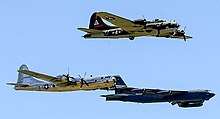
Overview
[edit]The B-52 shared many technological similarities with the preceding B-47 Stratojet strategic bomber. The two aircraft used the same basic design, such as swept wings and podded jet engines,[88]and the cabin included the crew ejection systems.[89]On the B-52D, the pilots and electronic countermeasures (ECM) operator ejected upwards, while the lower deck crew ejected downwards; until the B-52G, the gunner had to jettison the tail gun tobail out.[90]The tail gunner in early model B-52s was located in the traditional location in the tail of the plane, with both visual andradargun layingsystems; in later models, the gunner was moved to the front of the fuselage, with gun laying carried out by radar alone, much like the B-58 Hustler's tail gun system.[91]
Structural fatiguewas accelerated by at least a factor of eight in a low-altitude flight profile over that of high-altitude flying, requiring costly repairs to extend service life. In the early 1960s, the three-phaseHigh Stressprogram was launched to counter structural fatigue, enrolling aircraft at 2,000 flying hours.[92]Follow-up programs were conducted, such as a 2,000-hour service life extension to select airframes in 1966–1968, and the extensivePacer Plankreskinning, completed in 1977.[93]Thewet wingintroduced on G and H models was even more susceptible to fatigue, experiencing 60% more stress during a flight than the old wing. The wings were modified by 1964 underECP 1050.[94]This was followed by a fuselage skin andlongeronreplacement (ECP 1185) in 1966, and theB-52 Stability Augmentation and Flight Controlprogram (ECP 1195) in 1967.[94]Fuel leaks due to deterioratingMarman clampscontinued to plague all variants of the B-52. To this end, all aircraft variants were subjected toBlue Band(1957),Hard Shell(1958), and finallyQuickClip(1958) programs. The latter fitted safety straps that prevented catastrophic loss of fuel in case of clamp failure.[95]The B-52's service ceiling is officially listed as 50,000 feet (15,000 m), but operational experience shows this is difficult to reach when fully laden with bombs. According to one source: "The optimal altitude for a combat mission was around 43,000 feet (13,000 m), because to exceed that height would rapidly degrade the plane's range."[96]

In September 2006, the B-52 became one of the first US military aircraft to fly using alternative fuel. It took off fromEdwards Air Force Basewith a 50/50 blend ofFischer–Tropsch process(FT) synthetic fuel and conventionalJP-8jet fuel, which burned in two of the eight engines. On 15 December 2006, a B-52 took off from Edwards with the synthetic fuel powering all eight engines, the first time a USAF aircraft was entirely powered by the blend. The seven-hour flight was considered a success. This program is part of theDepartment of DefenseAssured Fuel Initiative,which aimed to reduce crude oil usage and obtain half of its aviation fuel from alternative sources by 2016.[98]On 8 August 2007,Air Force SecretaryMichael Wynnecertified the B-52H as fully approved to use the FT blend.[99]
Flight controls
[edit]Because of the B-52's mission parameters, only modest maneuvers would be required with no need forspinrecovery. The aircraft has a relatively small, narrowchordrudder,giving it limitedyawcontrol authority. Originally an all-movingvertical stabilizerwas to be used but was abandoned because of doubts about hydraulic actuator reliability.[100]Because the aircraft has eight engines,asymmetrical thrustdue to the loss of an engine in flight would be minimal and correctable with the narrow rudder. To assist with crosswind takeoffs and landings the mainlanding gearcan be pivoted 20 degrees to either side from neutral.[101]The crew would preset the yaw adjustable crosswind landing gear according to wind observations made on the ground.
Like the rudder, theelevatoris also very narrow chord and the B-52 suffers from limited elevator control authority. For long-term pitch trim and airspeed changes the aircraft uses astabilator(or all-moving tail) with the elevator used for small adjustments within a stabilizer setting. The stabilizer is adjustable through 13 degrees of movement (nine up, four down) and is crucial to operations during takeoff and landing due to large pitch changes induced byflapapplication.[102]
B-52s prior to the G models had very smallaileronswith a short span that was approximately equal to their chord. These "feeler ailerons" were used to provide feedback forces to the pilot's control yoke and to fine-tune the roll axes during delicate maneuvers such as aerial refueling. Due to twisting of the thin main wing, conventional outboard flap-type ailerons would lose authority and therefore could not be used. In other words, aileron activation would cause the wing to twist, undermining roll control. Sixspoileronson each wing are responsible for the majority of roll control. The late B-52G models eliminated the ailerons altogether and added an extra spoileron to each wing.[100]Partly because of the lack of ailerons, the B-52G and H models were more susceptible toDutch roll.[102]
Avionics
[edit]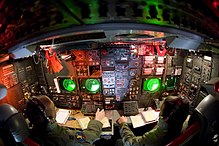
Ongoing problems with avionics systems were addressed in theJolly Wellprogram, completed in 1964, which improved components of the AN/ASQ-38 bombing navigational computer and the terrain computer. The MADREC (Malfunction Detection and Recording) upgrade fitted to most aircraft by 1965 could detect failures in avionics and weapons computer systems and was essential in monitoring theAGM-28 Hound Dogmissiles. Theelectronic countermeasurescapability of the B-52 was expanded withRivet Rambler(1971) andRivet Ace(1973).[103]
To improve operations at low altitudes, the AN/ASQ-151 Electro-Optical Viewing System (EVS), which consisted of alow light level television(LLLTV) and aforward looking infrared(FLIR) system mounted in blisters under the noses of B-52Gs and Hs between 1972 and 1976.[104]The navigational capabilities of the B-52 were later augmented with the addition ofGPSin the 1980s.[105]TheIBM AP-101,also used on theRockwell B-1 Lancerbomber and theSpace Shuttle,was the B-52's main computer.[106]
In 2007, theLITENING targeting podwas fitted, which increased the effectiveness of the aircraft in the attack of ground targets with a variety of standoff weapons, usinglaser guidance,a high-resolution forward-looking infrared sensor (FLIR), and aCCD cameraused to obtain target imagery.[107]LITENING pods have been fitted to a wide variety of other US aircraft, such as theMcDonnell Douglas F/A-18 Hornet,theGeneral Dynamics F-16 Fighting Falconand theMcDonnell Douglas AV-8B Harrier II.[108]
Armament
[edit]
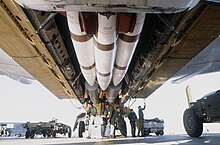
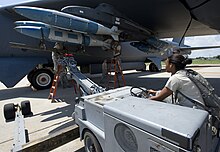
The ability to carry up to 20AGM-69 SRAMnuclear missiles was added to G and H models, starting in 1971.[109]To further improve its offensive ability, air-launched cruise missiles (ALCMs) were fitted.[110]After testing of both the USAF-backedBoeing AGM-86 Air Launched Cruise Missileand the Navy-backedGeneral Dynamics AGM-109 Tomahawk,the AGM-86B was selected for operation by the B-52 (and ultimately by the B-1 Lancer).[111]A total of 194 B-52Gs and Hs were modified to carry AGM-86s, carrying 12 missiles on underwing pylons, with 82 B-52Hs further modified to carry another eight missiles on a rotary launcher fitted in the bomb bay. To conform withSALT II Treatyrequirements that cruise missile-capable aircraft be readily identifiable by reconnaissance satellites, the cruise missile-armed B-52Gs were modified with a distinctivewing rootfairing.As all B-52Hs were assumed modified, no visual modification of these aircraft was required.[112]In 1990, the stealthyAGM-129 ACMcruise missile entered service; although intended to replace the AGM-86, the high cost and the Cold War's end led to only 450 being produced; unlike the AGM-86, no conventional, non-nuclear version was built.[113]The B-52 was to have been modified to utilizeNorthrop Grumman'sAGM-137 TSSAMweapon; however, the missile was canceled due to development costs.[114]
Those B-52Gs not converted as cruise missile carriers underwent a series of modifications to improve conventional bombing. They were fitted with a new Integrated Conventional Stores Management System (ICSMS) and new underwing pylons that could hold larger bombs or other stores than the external pylons could. Thirty B-52Gs were further modified to carry up to 12AGM-84 Harpoonanti-ship missileseach, while 12 B-52Gs were fitted to carry theAGM-142 Have Napstand-off air-to-ground missile.[115]When the B-52G was retired in 1994, an urgent scheme was launched to restore an interim Harpoon and Have Nap capability,[Note 3]the four aircraft being modified to carry Harpoon and four to carry Have Nap under theRapid Eightprogram.[117]
The Conventional Enhancement Modification (CEM) program gave the B-52H a more comprehensive conventional weapons capability, adding the modified underwing weapon pylons used by conventional-armed B-52Gs, Harpoon and Have Nap, and the capability to carry new-generation weapons including theJoint Direct Attack Munition(JDAM) andWind Corrected Munitions Dispenserguided bombs, theAGM-154glide bomb and theAGM-158 JASSMmissile. The CEM program also introduced new radios, integratedGlobal Positioning Systeminto the aircraft's navigation system, and replaced the under-nose FLIR with a more modern unit. Forty-seven B-52Hs were modified under the CEM program by 1996, with 19 more by the end of 1999.[118]
By around 2010,U.S. Strategic Commandstopped assigningB61andB83nuclear gravity bombs to B-52, and later listed only theB-2as tasked with delivering strategic nuclear bombs in budget requests. Nuclear gravity bombs were removed from the B-52's capabilities because it is no longer considered survivable enough to penetrate modern air defenses, instead relying on nuclear cruise missiles and focusing on expanding its conventional strike role.[119]The 2019 "Safety Rules for U.S. Strategic Bomber Aircraft" manual subsequently confirmed the removal of B61-7 and B83-1 gravity bombs from the B-52H's approved weapons configuration.[120]
Starting in 2016, Boeing is to upgrade the internal rotary launchers to the MIL-STD-1760 interface to enable the internal carriage of smart bombs, which previously could be carried only on the wings.[121]
While the B-1 Lancer has a larger theoretical maximum payload of 75,000 pounds (34,000 kg) compared to the B-52's 70,000 pounds (32,000 kg), the bombers are rarely able to carry their full loads. The most the B-52 carries is a full load of AGM-86Bs totaling 62,660 pounds (28,420 kg). The B-1 has the internal weapons bay space to carry more GBU-31 JDAMs and JASSMs, but the B-52 upgraded with the conventional rotary launcher can carry more of other JDAM variants.[122]
TheAGM-183AAir-Launched Rapid Response (ARRW)hypersonicmissile and the futureLong Range Stand Off(LRSO)nuclear-armedair-launched cruise missilewill join the B-52 inventory in the future.[123]
Engines
[edit]
The eight engines of the B-52 are paired in pods and suspended by four pylons beneath and forward of the wings'leading edge.The careful arrangement of the pylons also allowed them to work aswing fencesand delay the onset ofstall.The first two prototypes, XB-52 and YB-52, were both powered by experimentalPratt & Whitney YJ57-P-3turbojet engines with 8,700 pounds-force (39 kN) of static thrust each.[102]
The B-52A models were equipped with Pratt & Whitney J57-P-1W turbojets, providing a dry thrust of 10,000 pounds-force (44 kN) which could be increased for short periods to 11,000 pounds-force (49 kN) withwater injection.The water was carried in a 360 US gallons (1,400 L) tank in the rear fuselage.[124]
B-52B, C, D and E models were equipped with Pratt & Whitney J57-P-29W, J57-P-29WA, or J57-P-19W series engines all rated at 10,500 lbf (47 kN). The B-52F and G models were powered by Pratt & Whitney J57-P-43WB turbojets, each rated at 13,750 pounds-force (61.2 kN) static thrust with water injection.
On 9 May 1961, the B-52H began to be delivered to the USAF with cleaner burning and quieterPratt & Whitney TF33-P-3turbofanswith a maximum thrust of 17,100 pounds-force (76 kN).[102]
Engine retrofit
[edit]In a study for the USAF in the mid-1970s, Boeing investigated replacing the engines, changing to a new wing, and other improvements to upgrade B-52G/H aircraft as an alternative to the B-1A, then in development.[125]
In 1996, Rolls-Royce and Boeing jointly proposed fitting each B-52 with four leasedRolls-Royce RB211engines. This would have involved replacing the eight Pratt & Whitney TF33 engines (total thrust 136,000 lbf (600 kN)) with four RB211-535E4 engines (total thrust 172,400 lbf (767 kN)), which would increase range and reduce fuel consumption.[126][127]However, a USAF analysis in 1997 concluded that Boeing's estimated savings ofUS$4.7billion would not be realized and that reengining would instead costUS$1.3billion more than keeping the existing engines, citing significant up-front procurement and re-tooling expenditure.[128]
The USAF's 1997 rejection of reengining was subsequently disputed in aDefense Science Board(DSB) report in 2003. The DSB urged the USAF to re-engine the aircraft without delay,[129]saying doing so would not only create significant cost savings but reducegreenhouse gas emissionsand increase aircraft range and endurance; these conclusions were in line with the conclusions of a separate Congress-funded study conducted in 2003. Criticizing the USAF cost analysis, the DSB found that among other things, the USAF failed to account for the cost of aerial refueling; the DSB estimated that aerial refueling cost $17.50 per US gallon ($4.62/L), whereas the USAF had failed to account for the cost of delivering the fuel and so had only priced fuel at $1.20 per US gallon ($0.32/L).[130]
On 23 April 2020, the USAF released its request for proposals for 608 commercial engines plus spares and support equipment, with the plan to award the contract in May 2021.[131]This Commercial Engine Reengining Program (CERP) saw General Electric propose itsCF34-10andPassportturbofans, Pratt & Whitney itsPW800,and the Rolls-Royce BR725 to be designatedF130.[131]On 24 September 2021, the USAF selected the Rolls-Royce F130 as the winner and announced plans to purchase 650 engines (608 direct replacements and 42 spares), forUS$2.6billion.[132][133]
Unlike the previous re-engine proposal which also involved reducing the number of engines from eight to four, the F130 re-engine program maintains eight engines on the B-52. Although four-engine operation would be more efficient, retrofitting the airframe to operate with only four engines would involve additional changes to the aircraft's systems and control surfaces (particularly the rudder), thereby increasing the time, cost, and complexity of the project.[134]B-52Hs upgraded withRolls Royce F130engines will be redesignated as "B-52Js".[133]
Costs
[edit]| Inflation year | X/YB-52 | B-52A | B-52B | B-52C | B-52D | B-52E | B-52F | B-52G | B-52H | |
|---|---|---|---|---|---|---|---|---|---|---|
| UnitR&Dcost | 1955 | 100 M | ||||||||
| Current | 1,137 M | |||||||||
| Airframe | 1955 | 26.433 M | 11.328 M | 5.359 M | 4.654 M | 3.700 M | 3.772 M | 5.352 M | 6.076 M | |
| Engines | 1955 | 2.848 M | 2.547 M | 1.513 M | 1.291 M | 1.257 M | 1.787 M | 1.428 M | 1.640 M | |
| Electronics | 1955 | 50,761 | 61,198 | 71,397 | 68,613 | 54,933 | 60,111 | 66,374 | 61,020 | |
| Armament and ordnance | 1955 | 57,067 | 494 K | 304 K | 566 K | 936 K | 866 K | 847 K | 1.508 M | |
| Current | 649,075 | 5.62 M | 3.46 M | 6.441 M | 10.65 M | 9.85 M | 9.63 M | 17.1 M | ||
| Flyaway cost | 1955 | 28.38 M | 14.43 M | 7.24 M | 6.58 M | 5.94 M | 6.48 M | 7.69 M | 9.29 M | |
| Current | 322.8 M | 164.1 M | 82.3 M | 74.8 M | 67.6 M | 74.8 M | 87.5 M | 105.7 M | ||
| Maintenance cost per flying hour | 1955 | 925 | 1,025 | 1,025 | 1,182 | |||||
| Current | 10,521 | 11,658 | 11,658 | 13,444 | ||||||
| Note: The original costs were in approximate 1955 United States dollars.[135]Figures in tables noted withcurrenthave been adjusted for inflation to the current calendar year.[30] | ||||||||||
Operational history
[edit]Introduction
[edit]Although the B-52A was the first production variant, these aircraft were used only in testing. The first operational version was the B-52B which had been developed in parallel with the prototypes since 1951. First flying in December 1954, B-52B, AF Serial Number 52-8711, entered operational service with93rd Heavy Bombardment Wing(93rd BW) atCastle Air Force Base,California, on 29 June 1955. The wing became operational on 12 March 1956. The training for B-52 crews consisted of five weeks of ground school and four weeks of flying, accumulating 35 to 50 hours in the air. The new B-52Bs replaced operational B-36s on a one-to-one basis.[136]
Early operations were problematic;[137]in addition to supply problems, there were also technical issues.[138]Ramps and taxiways deteriorated under the aircraft's weight, the fuel system was prone to leaks and icing,[139]and bombing and fire control computers were unreliable.[138]The split-level cockpit presented a temperature control problem– the pilots' cockpit was heated by sunlight while the observer and the navigator on the bottom deck sat on the ice-cold floor. Thus, a comfortable temperature setting for the pilots caused the other crew members to freeze, while a comfortable temperature for the bottom crew caused the pilots to overheat.[140]The J57 engines proved unreliable.Alternatorfailure caused the first fatal B-52 crash in February 1956;[141]as a result, the fleet was briefly grounded. In July, fuel and hydraulic issues grounded the B-52s again. In response to maintenance issues, the USAF set up "Sky Speed" teams of 50 contractors at each B-52 base to perform maintenance and routine checkups, taking an average of one week per aircraft.[142]

On 21 May 1956, a B-52B (52-13) dropped aMk-15 nuclear bombover theBikini Atollin a test code-namedCherokee.It was the first air-droppedthermonuclear weapon.[143]This aircraft now is on display at theNational Museum of Nuclear Science and Historyin Albuquerque, NM. From 24 to 25 November 1956, four B-52Bs of the 93rd BW and four B-52Cs of the 42nd BW flew nonstop around the perimeter of North America inOperation Quick Kick,which covered 15,530 miles (13,500 nmi; 24,990 km) in 31 hours, 30 minutes. SAC noted the flight time could have been reduced by 5 to 6 hours had the four inflight refuelings been done by fast jet-powered tanker aircraft rather than propeller-drivenBoeing KC-97 Stratofreighters.[144]In a demonstration of the B-52's global reach, from 16 to 18 January 1957, three B-52Bs made anon-stop flightaround the world duringOperation Power Flite,during which 24,325 miles (21,138 nmi; 39,147 km) was covered in 45 hours 19 minutes (536.8 mph or 863.9 km/h) with several in-flight refuelings by KC-97s.[145][Note 4]
The B-52 set many records over the next few years. On 26 September 1958, a B-52D set a world speed record of 560.705 miles per hour (487.239 kn; 902.367 km/h) over a 10,000 kilometers (6,200 miles; 5,400 nautical miles) closed circuit without a payload. The same day, another B-52D established a world speed record of 597.675 miles per hour (519.365 kn; 961.865 km/h) over a 5,000 kilometers (3,100 miles; 2,700 nautical miles) closed circuit without a payload.[146]On 14 December 1960, a B-52G set a world distance record by flying unrefueled for 10,078.84 miles (8,758.27 nmi; 16,220.32 km); the flight lasted 19 hours 44 minutes (510.75 mph or 821.97 km/h).[147]From 10 to 11 January 1962, a B-52H (60-40) set a world distance record by flying unrefueled, surpassing the prior B-52 record set two years earlier, fromKadena Air Base,Okinawa Prefecture,Japan, toTorrejón Air Base,Spain, which covered 12,532.28 miles (10,890.25 nmi; 20,168.75 km).[64][148]The flight passed over Seattle, Fort Worth and the Azores.
Cold War
[edit]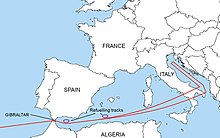
When the B-52 entered service, theStrategic Air Command(SAC) intended to use it to deter and counteract the vast and modernizingSoviet Union's military. As the Soviet Union increased its nuclear capabilities, destroying or "countering" the forces that would deliver nuclear strikes (bombers, missiles, etc.) became of great strategic importance.[149]TheEisenhower administrationendorsed this switch in focus; the President in 1954 expressed a preference for military targets over civilian ones, a principle reinforced in theSingle Integrated Operation Plan(SIOP), a plan of action in the case of nuclear war breaking out.[150]
Throughout theCold War,B-52s and other US strategic bombers performed airborne alert patrols under code names such asHead Start,Chrome Dome,Hard Head,Round RobinandGiant Lance.Bombersloiteredat high altitudes near the borders of the Soviet Union to provide rapid first strike or retaliation capability in case of nuclear war.[151]These airborne patrols formed one component of the US's nuclear deterrent, which would act to prevent the breakout of a large-scale war between the US and the Soviet Union under the concept ofMutually Assured Destruction.[152]
Due to the late 1950s-era threat ofsurface-to-air missiles(SAMs) that could threaten high-altitude aircraft,[153]seen in practice in the1960 U-2 incident,[154]the intended use of B-52 was changed to serve as alow-levelpenetration bomber during a foreseen attack upon the Soviet Union, asterrain maskingprovided an effective method of avoiding radar and thus the threat of the SAMs.[155]The aircraft was planned to fly towards the target at 400–440 mph (640–710 km/h) and deliver their weapons from 400 ft (120 m) or lower.[156]Although never intended for the low-level role, the B-52's flexibility allowed it to outlast several intended successors as the nature of aerial warfare changed. The B-52's large airframe enabled the addition of multiple design improvements, new equipment, and other adaptations over its service life.[157]
In November 1959, to improve the aircraft's combat capabilities in the changing strategic environment, SAC initiated theBig Fourmodification program (also known asModification 1000) for all operational B-52s except early B models.[158]The program was completed by 1963.[159]The four modifications were the ability to launch AGM-28 Hound Dog standoff nuclear missiles andADM-20 Quaildecoys, an advanced electronic countermeasures (ECM) suite, and upgrades to perform the all-weather, low-altitude (below 500 feet or 150 m) interdiction mission in the face of advancing Soviet missile-based air defenses.[159]
In the 1960s, there were concerns over the fleet's capable lifespan. Several projects beyond the B-52, theConvair B-58 HustlerandNorth American XB-70 Valkyrie,had either been aborted or proved disappointing in light of changing requirements, which left the older B-52 as the main bomber as opposed to the planned successive aircraft models.[160]On 19 February 1965, General Curtis E. LeMay testified to Congress that the lack of a follow-up bomber project to the B-52 raised the danger that, "The B-52 is going to fall apart on us before we can get a replacement for it."[161]Other aircraft, such as theGeneral Dynamics F-111 Aardvark,later complemented the B-52 in roles the aircraft was not as capable in, such as missions involving high-speed, low-level penetration dashes.[162]
Vietnam War
[edit]
With the escalating situation in Southeast Asia, 28 B-52Fs were fitted with external racks for 24 of the 750 pounds (340 kg) bombs under projectSouth Bayin June 1964; an additional 46 aircraft received similar modifications under projectSun Bath.[72]In March 1965, the United States commencedOperation Rolling Thunder.The first combat mission,Operation Arc Light,was flown by B-52Fs on 18 June 1965, when 30 bombers of the 9th and 441st Bombardment Squadrons struck a communist stronghold near theBến Cát Districtin South Vietnam. The first wave of bombers arrived too early at a designated rendezvous point, and while maneuvering to maintain station, two B-52s collided, which resulted in the loss of both bombers and eight crewmen. The remaining bombers, minus one more that turned back due to mechanical problems, continued towards the target.[163]Twenty-seven Stratofortresses bombed a one-by-two-mile (1.6 by 3.2 km) target box from between 19,000 and 22,000 feet (5,800 and 6,700 m), with a little more than 50% of the bombs falling within the target zone.[164]The force returned toAndersen Air Force Baseexcept for one bomber with electrical problems that recovered toClark Air Base,the mission having lasted 13 hours. Post-strike assessment by teams of South Vietnamese troops with American advisors found evidence that the Viet Cong had departed from the area before the raid, and it was suspected that infiltration of the south's forces may have tipped off the north because of theSouth Vietnamese Armytroops involved in the post-strike inspection.[165]
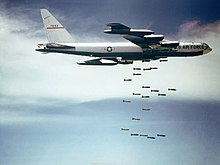
Beginning in late 1965, a number of B-52Ds underwentBig Bellymodifications to increase bomb capacity forcarpet bombings.[166]While the external payload remained at 24 of 500 pounds (230 kg) or 750 pounds (340 kg) bombs, the internal capacity increased from 27 to 84 for 500 lb (230 kg) bombs, or from 27 to 42 for 750 lb (340 kg) bombs.[167]The modification created enough capacity for a total of 60,000 pounds (27,000 kg) using 108 bombs. Thus modified, B-52Ds could carry 22,000 pounds (10,000 kg) more than B-52Fs.[168]Designed to replace B-52Fs, modified B-52Ds entered combat in April 1966 flying fromAndersen Air Force Base,Guam.Each bombing mission lasted 10 to 12 hours and included an aerial refueling byKC-135 Stratotankers.[51]In spring 1967, B-52s began flying fromU-Tapao Airfieldin Thailand so that refueling was not required.[167]
B-52s were employed during theBattle of Ia Drangin November 1965, notable as the aircraft's first use in a tactical support role.[169]
The B-52s were restricted to bombing suspected Communist bases in relatively uninhabited sections because their potency approached that of a tactical nuclear weapon. A formation of six B-52s, dropping their bombs from 30,000 ft (9,100 m), could "take out"... almost everything within a "box" approximately five-eighths mile wide by two miles long (1km × 3.2km). WheneverArc Lightstruck... in the vicinity of Saigon, the city woke from the tremor...
Neil Sheehan,war correspondent, writing before the mass attacks on heavily populated cities including North Vietnam's capital.[170]
On 22 November 1972, a B-52D (55-110) from U-Tapao was hit by a SAM while on a raid overVinh.The crew was forced to abandon the damaged aircraft over Thailand. This was the first B-52 destroyed by hostile fire.[171][172][173]
The zenith of B-52 attacks in Vietnam wasOperation Linebacker II(also known as the Christmas bombings), conducted from 18 to 29 December 1972, which consisted of waves of B-52s (mostly D models, but some Gs without jamming equipment and with a smaller bomb load). Over 12 days, B-52s flew 729sortiesand dropped 15,237 tons of bombs onHanoi,Haiphong,and other targets in North Vietnam.[174]Originally 42 B-52s were committed to the war; however, numbers were frequently twice this figure.[175]During Operation Linebacker II, fifteen B-52s were shot down, five were heavily damaged (one crashed in Laos), and five suffered medium damage. A total of 25 crewmen were killed in these losses.[176]During the war, 31 B-52s were lost, including ten shot down over North Vietnam.[177]
Air-to-air combat
[edit]
During theVietnam War,B-52Dtail gunnerswere credited with shooting down twoMiG-21 "Fishbeds".On 18 December 1972 tail gunnerStaff SergeantSamuel O. Turner's B-52 had just completed a bomb run for Operation Linebacker II and was turning away when aVietnam People's Air Force(VPAF) MiG-21 approached.[178]The MiG and the B-52 locked onto each other. When the fighter drew within range, Turner fired his quad (four guns on one mounting).50 (12.7 mm) caliber machine guns.[179]The MiG exploded aft of the bomber,[178]as confirmed byMaster SergeantLouis E. Le Blanc, the tail gunner in a nearby Stratofortress. Turner received aSilver Starfor his actions.[180]His B-52, tail number 56-676, is preserved on display with air-to-air kill markings atFairchild Air Force BaseinSpokane,Washington.[178]
On 24 December 1972, during the same bombing campaign, the B-52Diamond Lilwas headed to bomb theThái Nguyênrailroad yardswhen tail gunnerAirman First ClassAlbert E. Moore spotted a fast-approaching MiG-21.[181]Moore opened fire with his quad.50 caliber guns at 4,000 yd (3,700 m), and kept shooting until the fighter disappeared from his scope.Technical SergeantClarence W. Chute, a tail gunner aboard another Stratofortress, watched the MiG catch fire and fall away;[179]this was not confirmed by the VPAF.[182]Diamond Lilis preserved on display at theUnited States Air Force AcademyinColorado.[181]Moore was the lastbombergunner believed to have shot down an enemy aircraft with machine guns inaerial combat.[179]
The two B-52 tail gunner kills were not confirmed by VPAF, and they admitted to the loss of only three MiGs, all by F-4s.[182]Vietnamese sources have attributed a third air-to-air victory to a B-52, a MiG-21 shot down on 16 April 1972.[183]These victories make the B-52 the largest aircraft credited with air-to-air kills.[Note 5]The last Arc Light mission without fighter escort took place on 15 August 1973, as U.S. military action in Southeast Asia was wound down.[184]
Post-Vietnam War service
[edit]B-52Bs reached the end of their structural service life by the mid-1960s and all were retired by June 1966, followed by the last of the B-52Cs on 29 September 1971; except forNASA's B-52B "008"which was eventually retired in 2004 atEdwards Air Force Base,California.[185]Another of the remaining B Models, "52-005"is on display at theWings Over the Rockies Air and Space MuseuminDenver,Colorado.[186]

A few time-expired E models were retired in 1967 and 1968, but the bulk (82) were retired between May 1969 and March 1970. Most F models were also retired between 1967 and 1973, but 23 survived as trainers until late 1978. The fleet of D models served much longer;[187]80 D models were extensively overhauled under thePacer Plankprogram during the mid-1970s.[188]Skinning on the lower wing and fuselage was replaced, and various structural components were renewed. The fleet of D models stayed largely intact until late 1978 when 37 not already upgraded Ds were retired.[189]The remainder were retired between 1982 and 1983.[190]
The remaining G and H models were used for nuclear standby ( "alert" ) duty as part of the United States'nuclear triad;the combination of nuclear-armed land-based missiles, submarine-based missiles, and manned bombers. The B-1, intended to supplant the B-52, replaced only the older models and the supersonic FB-111.[191]In 1991, B-52s ceased continuous 24-hour SAC alert duty.[192]
After Vietnam, the experience of operations in a hostile air defense environment was considered. Due to this, B-52s were modernized with new weapons, equipment, and both offensive and defensive avionics. This, and the use of low-level tactics, marked a major shift in the B-52's utility. The upgrades were:
- Supersonic short-range nuclear missiles: G and H models were modified to carry up to 20 SRAM missiles replacing existing gravity bombs. Eight SRAMs were carried internally on a special rotary launcher and 12 SRAMs were mounted on two wing pylons. With SRAM, the B-52s could strike heavily defended targets without entering the terminal defenses.
- New countermeasures: Phase VI ECM modification was the sixth major ECM program for the B-52. It improved the aircraft's self-protection capability in the dense Soviet air defense environment. The new equipment expanded signal coverage, improved threat warnings, provided new countermeasures techniques, and increased the quantity of expendables. The power requirements of Phase VI ECM also consumed most of the excess electrical capacity on the B-52G.
- B-52G and Hs were also modified with an electro-optical viewing system (EVS) that made low-level operations and terrain avoidance much easier and safer. EVS system contained a low light level television (LLTV) camera and a forward-looking infrared (FLIR) camera to display information needed for penetration at lower altitudes.
- Subsonic-cruise unarmed decoy: SCUD resembled the B-52 on the radar. As an active decoy, it carried ECM and other devices, and it had a range of several hundred miles. Although SCUD was never deployed operationally, the concept was developed, becoming known as the air-launched cruise missile (ALCM-A).
These modifications increased weight by nearly 24,000 pounds (11,000 kg) and decreased operational range by 8–11%. This was considered acceptable for the increase in capabilities.[193]
After the fall of the Soviet Union, all B-52Gs remaining in service were destroyed in accordance with the terms of theStrategic Arms Reduction Treaty(START). TheAerospace Maintenance and Regeneration Center(AMRC) cut the 365 B-52s into pieces. Russia verified the completion destruction task via satellite and first-person inspection at the AMARC facility.[194]
Gulf War and later
[edit]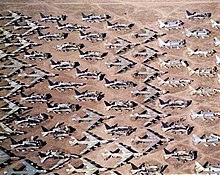
B-52 strikes were an important part ofOperation Desert Storm.Starting on 16 January 1991, a flight of B-52Gs flew fromBarksdale Air Force Base,Louisiana, refueled in the air enroute, struck targets in Iraq, and returned home – a journey of 35 hours and 14,000 miles (23,000 km) round trip. It set a record for the longest-distance combat mission, breaking the record previously held by an RAFVulcan bomberin 1982; however, this was achieved using forward refueling.[10][196]Those seven B-52s flew the first combat sorties of Operation Desert Storm, firing 35AGM-86C CALCMstandoff missiles and successfully destroying 85–95 percent of their targets.[197]B-52Gs operating from theKing Abdullah Air Baseat Jeddah, Saudi Arabia,RAF Fairfordin the United Kingdom,Morón Air Base,Spain, and the island ofDiego Garciain theBritish Indian Ocean Territoryflew bombing missions over Iraq, initially at low altitude. After the first three nights, the B-52s moved to high-altitude missions instead, which reduced their effectiveness and psychological impact compared to the low-altitude role initially played.[198]
The conventional strikes were carried out by three bombers, which dropped up to 153 of the 750 lb (340 kg)M117 bombover an area of 1.5 by 1 mi (2.4 by 1.6 km). The bombings demoralized the defending Iraqi troops, many of whom surrendered in the wake of the strikes.[199]In 1999, the science and technology magazinePopular Mechanicsdescribed the B-52's role in the conflict: "The Buff's value was made clear during the Gulf War and Desert Fox. The B-52 turned out the lights in Baghdad."[200]During Operation Desert Storm, B-52s flew about 1,620 sorties and delivered 40% of the weapons dropped by coalition forces.[3]
During the conflict, several claims of Iraqi air-to-air successes were made, including an Iraqi pilot, Khudai Hijab, who allegedly fired aVympel R-27R missile from hisMiG-29and damaged a B-52G on the opening night of the Gulf War.[201]However, the USAF disputes this claim, stating the bomber was actually hit by friendly fire, anAGM-88High-speed, Anti-Radiation Missile (HARM) that homed on the fire-control radar of the B-52's tail gun; the jet was subsequently nicknamedIn HARM's Way.[202]Shortly following this incident, GeneralGeorge Lee Butlerannounced that the gunner position on B-52 crews would be eliminated, and the gun turrets permanently deactivated, commencing on 1 October 1991.[203]
Since the mid-1990s, the B-52H has been the only variant remaining in military service;[Note 6]it is currently stationed at:
- Minot Air Force Base,North Dakota–5th Bomb Wing
- Barksdale Air Force Base,Louisiana–2nd Bomb Wing(active Air Force) and307th Bomb Wing(Air Force Reserve Command)
- One B-52H is assigned toEdwards Air Force Baseand is used byAir Force Materiel Commandat the USAF Flight Test Center.
- One additional B-52H is used by NASA atDryden Flight Research Center,California as part of the Heavy-lift Airborne Launch program.[204]
From 2 to 3 September 1996, two B-52Hs conducted a mission as part ofOperation Desert Strike.The B-52s struck Baghdad power stations and communications facilities with 13 AGM-86C conventional air-launched cruise missiles (CALCM) during a 34-hour, 16,000 mi (26,000 km) round trip mission from Andersen Air Force Base, Guam, the longest distance ever flown for a combat mission.[205]

On 24 March 1999, whenOperation Allied Forcebegan, B-52 bombers bombarded Serb targets throughout theFederal Republic of Yugoslavia,including during theBattle of Kosare.[206]
The B-52 contributed toOperation Enduring Freedomin 2001 (Afghanistan/Southwest Asia), providing the ability to loiter high above the battlefield and provide Close Air Support (CAS) through the use of precision-guided munitions, a mission which previously would have been restricted to fighter and ground attack aircraft.[207]In late 2001, ten B-52s dropped a third of the bomb tonnage in Afghanistan.[208]B-52s also played a role inOperation Iraqi Freedom,which commenced on 20 March 2003 (Iraq/Southwest Asia). On the night of 21 March 2003, B-52Hs launched at least 100 AGM-86C CALCMs at targets within Iraq.[209]
B-52 and maritime operations
[edit]The B-52 can be highly effective for ocean surveillance and can assist the Navy in anti-ship and mine-laying operations. For example, a pair of B-52s, in two hours, can monitor 140,000 square miles (360,000 square kilometers) of the ocean surface. During the 2018 Baltops exercise B-52s conducted mine-laying missions off the coasts of Sweden, simulating a counter-amphibious invasion mission in the Baltic.[193][210]
In the 1970s, the U.S. Navy worried that combined attacks from Soviet bombers, submarines, and warships could overwhelm its defenses and sink its aircraft carriers. After theFalklands War,US planners feared the damage that could be created by 200-mile (170 nmi; 320 km)-range missiles carried byTupolev Tu-22M"Backfire" bombers and 250-mile (220 nmi; 400 km)-range missiles carried by Soviet surface ships. New US Navy's maritime strategy in the early 1980s called for the aggressive use of carriers and surface action groups against the Soviet navy. To help protect the carrier battle groups, some B-52G were modified to fire Harpoon anti-ship missiles. These bombers were based in Guam and Maine in the later 1970s to support both the Atlantic and Pacific fleets. In case of war, B-52s would coordinate with tanker support and surveillance by AWACS and Navy planes. B-52Gs could strike Soviet navy targets on the flanks of the US carrier battle groups, leaving them free to concentrate on offensive strikes against Soviet surface combatants. Mines laid down by B-52s could establish minefields in significant enemy chokepoints (mainly theKuril Islandsand theGIUK gap). These minefields would force the Soviet fleet to disperse, making individual ships more vulnerable to Harpoon attacks.[211][212]
From the 1980s B-52Hs were modified to use Harpoons in addition to a wide range of cruise missiles, laser- and satellite-guided bombs, and unguided munitions. B-52 bomber crews honed sea-skimming flight profiles that would allow them to penetrate stiff enemy defenses and attack Soviet ships.[213][214][215]
Recent expansion and modernization of thePeople's Liberation Army Navyof China have caused the USAF to re-implement strategies for finding and attacking ships. The B-52 fleet has been certified to use theQuickstrikefamily of naval mines using JDAM-ER guided wing kits. This weapon provides the ability to lay down minefields over wide areas, in a single pass, with extreme accuracy, all while standing-off over 40 miles (35 nmi; 64 km) away. Besides this, with a view to enhancing B-52 maritime patrol and strike performance, an AN/ASQ-236 Dragon's Eye underwing pod, has also been certified for use by B-52H bombers. Dragon's Eye contains an advanced electronically scanned array radar that will allow B-52s to quickly scan vast Pacific Ocean areas, so finding and sinking enemy ships will be easier for them. This radar will complement theLiteninginfrared targeting pod already used by B-52s for inspecting ships.[216][217]In 2019, Boeing selected theRaytheonAN/APG-82(V)1 radar to replace its mechanically scanningAN/APQ-166attack radar.[218][219]
21st century service
[edit]

In August 2007, a B-52H ferrying AGM-129 ACM cruise missiles from Minot Air Force Base to Barksdale Air Force Base for dismantling wasmistakenly loadedwith six missiles with their nuclear warheads. The weapons did not leave USAF custody and were secured at Barksdale.[220][221]
Four of 18 B-52Hs fromBarksdale Air Force Basewere retired and were in the "boneyard" of 309th AMARG atDavis-Monthan Air Force Baseas of 8 September 2008.[222]
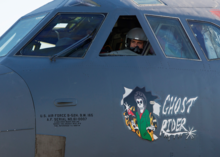
In February 2015, hull 61-0007Ghost Riderbecame the first stored B-52 to return to service after six years in storage at Davis-Monthan Air Force Base.[223]

In May 2019, a second aircraft was resurrected from long-term storage in Davis-Monthan. The B-52, nicknamed "Wise Guy", had been at AMARG since 2008. It flew to Barksdale Air Force Base on 13 May 2019. It was completed in four months by a team of 13–20 maintainers from the 307th Maintenance Squadron.[224]
B-52s are periodically refurbished at USAF maintenance depots such asTinker Air Force Base,Oklahoma.[225]Even while the USAF works on the newLong Range Strike Bomber,it intends to keep the B-52H in service until 2050, which is 95 years after the B-52 first entered service, an unprecedented length of service for any aircraft, civilian or military.[3][226][227][Note 7]
The USAF continues to rely on the B-52 because it remains an effective and economical heavy bomber in the absence of sophisticated air defenses, particularly in the type of missions that have been conducted since the end of the Cold War against nations with limited defensive capabilities. The B-52 has also continued in service because there has been no reliable replacement.[230]The B-52 has the capacity to "loiter" for extended periods, and can deliver precisionstandoffanddirect firemunitions from a distance, in addition to direct bombing. It has been a valuable asset in supporting ground operations during conflicts such asOperation Iraqi Freedom.[231]The B-52 had the highestmission capable rateof the three types of heavy bombers operated by the USAF in the 2000–2001 period. The B-1 averaged a 53.7% ready rate, the B-2 Spirit achieved 30.3%, and the B-52 averaged 80.5%.[195]The B-52'sUS$72,000cost per hour of flight is more than the B-1B'sUS$63,000cost per hour, but less than the B-2'sUS$135,000per hour.[232]
The Long Range Strike Bomber program is intended to yield a stealthy successor for the B-52 and B-1 that would begin service in the 2020s; it is intended to produce 80 to 100 aircraft. Two competitors, Northrop Grumman and a joint team of Boeing and Lockheed Martin, submitted proposals in 2014;[233]Northrop Grumman was awarded a contract in October 2015.[234]
On 12 November 2015, the B-52 beganfreedom of navigationoperations in the South China Sea in response to Chinese human-made islands in the region. Chinese forces,claiming jurisdiction within a 12-mile exclusion zoneof the islands, ordered the bombers to leave the area, but they refused, not recognizing jurisdiction.[235]On 10 January 2016, a B-52 overflew parts of South Korea escorted by South Korean F-15Ks and U.S. F-16s in response to the supposed test of a hydrogen bomb by North Korea.[236]
On 9 April 2016, an undisclosed number of B-52s arrived atAl Udeid Air Basein Qatar as part ofOperation Inherent Resolve,part of themilitary intervention against ISIL.The B-52s took over heavy bombing afterB-1 Lancersthat had been conducting airstrikes rotated out of the region in January 2016.[237]In April 2016, B-52s arrived in Afghanistan to take part in the war in Afghanistan and began operations in July, proving its flexibility and precision carrying out close-air support missions.[238]
According to a statement by the U.S. military, an undisclosed number of B-52s participated in theU.S. strikeson pro-government forces in eastern Syria on 7 February 2018.[239]
A number of B-52s were deployed in airstrikes against the Taliban during the2021 Taliban offensive.[240]
In 2022, the US Air Force used a B-52 as a platform to test aHypersonic Air-breathing Weapon Concept(HAWC) missile.[241]
In late October 2022,ABC Newsreported that the USAF intended to deploy six B-52s atRAAF Tindalin Australia in the near future, which would include building facilities to handle the aircraft.[242]
Variants
[edit]| Variant | Produced | Entered service |
|---|---|---|
| XB-52 | 2 (1 redesignated YB-52) |
prototypes |
| YB-52 | 1 modified XB-52 | prototype |
| B-52A | 3 (1 redesignated NB-52A) |
test units |
| NB-52A | 1 modified B-52A | |
| B-52B | 50 | 29 June 1955 |
| RB-52B | 27 Modified B-52Bs | |
| NB-52B | 1 Modified B-52B | 1955 |
| B-52C | 35 | June 1956 |
| B-52D | 170 | December 1956 |
| B-52E | 100 | December 1957 |
| B-52F | 89 | June 1958 |
| B-52G | 193 | 13 February 1959 |
| B-52H | 102 | 9 May 1961 |
| Grand total | 744 production |
The B-52 went through several design changes and variants over its 10 years of production.[135]
XB-52
YB-52
B-52A
NB-52A

B-52B/RB-52B
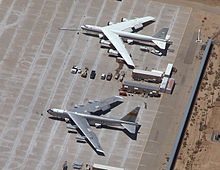
Of the 50 B-52Bs built, 27 were capable of carrying a reconnaissance pod as RB-52Bs (the crew was increased to eight in these aircraft).[243]The 300 pounds (140 kg) pod contained radio receivers, a combination of K-36, K-38, and T-11 cameras, and two operators on downward-firingejection seats.The pod required only four hours to install.[141]
Seven B-52Bs were brought to B-52C standard underProject Sunflower.[247]NB-52B
It was replaced by a modified B-52H.[249]
B-52C
RB-52C
B-52D
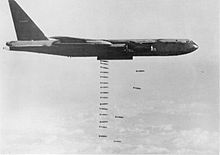
B-52E
JB-52E
NB-52E
B-52F
B-52G


B-52H

B-52J
XR-16A
Operators
[edit]

- United States Air Forceoperates 72 aircraft of the original 744 B-52 aircraft as of 2022.[261]
- Air Combat Command
- Air Force Global Strike Command
- 2d Bomb Wing– Barksdale Air Force Base, Louisiana[10]
- 5th Bomb Wing–Minot Air Force Base,North Dakota[2]
- Air Force Materiel Command
- 412th Test Wing– Edwards Air Force Base, California
- Air Force Reserve Command
- 307th Bomb Wing– Barksdale Air Force Base, Louisiana[267]
- NASA
- Dryden Flight Research Center
- 1 modified ex-USAF NB-52B (52-8)"Mothership" Launch Aircraftoperated from 1966 to 2004. It was then put on display at the North entrance to Edwards Air Force Base.[268]
- 1 modified ex-USAF B-52H (61-25) Heavy Lift Launch Aircraft operated from 2001 to 2008. On 9 May 2008, that aircraft was flown for the last time toSheppard Air Force Base,Texas, where it became a GB-52H maintenance trainer, never to fly again.[269]
- Dryden Flight Research Center
Notable accidents
[edit]List of incidents resulting in loss of life, severe injuries, or loss of aircraft.
- In 1956, there were three crashes in eight months, all atCastle Air Force Base.[270]
- The fourth crash occurred 42 days later on 10 January 1957 inNew Brunswick,Canada.[271][272]
- On 29 March 1957, B-52C (54-2676) retained by Boeing and used for tests as JB-52C, crashed during Boeing test flight from Wichita, Kansas. Two of the four crew on board were killed.[273]
- On 11 February 1958, B-52D (56-0610) crashed short of the runway atEllsworth AFB,South Dakota, due to total loss of power during final approach. Two of the eight crewmembers on board were killed in addition to three ground personnel. The crash was determined to be from frozen fuel lines that clogged fuel filters. It was previously unknown that jet fuel absorbs water vapor from the atmosphere. After this accident, over two hundred previous aircraft losses listed as "cause unknown" were attributed to frozen fuel lines.[274][275]
- On 8 September 1958, two B-52Ds (56‑0661 and 56‑0681) from the 92d Bombardment Wing collided in midair near Fairchild AFB. All thirteen crew members on the two aircraft were killed.[274]
- On 23 June 1959, B-52D (56‑0591), nicknamed "Tommy's Tigator", operating out ofLarson AFB,crashed in theOchoco National ForestnearBurns, Oregon.The aircraft was operated by Boeing personnel during a test flight and crashed after turbulence-induced failure in the horizontal stabilizer at a low elevation. All five Boeing personnel were killed.[274]
- On 15 October 1959, B-52F (57‑0036) from the4228th Strategic WingatColumbus AFB,Mississippi, carrying twonuclear weaponscollided in midair with a KC-135 tanker (57-1513) near Hardinsburg, Kentucky during amid-air refueling.Four of the eight crew members on the bomber and all four crew on the tanker were killed. One of the nuclear bombs was damaged by fire, but both weapons were recovered.[276]
- On 15 December 1960, B-52D (55‑0098) from the4170th Strategic Wingcollided with a KC-135 during mid-air refueling. The refueling probe from the KC-135 pierced the skin on the wing of the B-52. Upon landing atLarson AFB,the starboard wing failed, and the aircraft caught fire during the landing roll. The runway at Larson was damaged. All crew members were evacuated. The KC-135 landed at Fairchild AFB.[271]
- On 19 January 1961, B-52B (53‑0390), call sign "Felon 22", from the95th Bombardment Wingout ofBiggs AFB,El Paso, Texascrashed just north ofMonticello, Utahafter a turbulence-induced structural failure, the tail snapped off, at altitude. Only the copilot survived after ejecting. The other seven crewmen died.[277][278]

- On 24 January 1961, B-52G (58‑0187) from the4241st Strategic Wingbroke up in midair and crashedon approach toSeymour Johnson AFBnearGoldsboro, North Carolina,dropping twonuclear bombsin the process without detonation. The aircraft suffered a fuel leak at altitude due tofatiguefailure of the starboard wing. A loss of control resulted when the flaps were applied during the emergency approach to Seymour Johnson AFB. Three of the eight crew members were killed.[279][280]
- On 14 March 1961, B-52F (57‑0166) of the4134th Strategic Wingoperating out ofMather AFB,California, carrying two nuclear weapons experienced anuncontrolled decompression,necessitating a descent to 10,000 feet (3,000 m) to lower thecabin altitude.Due to increased fuel consumption at the lower altitude and being unable to rendezvous with a tanker in time, the aircraft ran out of fuel. The crew ejected safely, while thenow-unmanned bomber crashed15 miles (24 km) west ofYuba City, California.[276][281][282][verification needed]
- On 7 April 1961, B-52B (53‑0380), nicknamed "Ciudad Juarez", from the 95th Bombardment Wing out of Biggs AFB was accidentally shot down by the launch of aAIM-9 Sidewinderfrom aF-100A Super Sabre(53-1662) of theNew Mexico Air National Guardduring a practice intercept maneuver. The missile struck the engine pylon on the B-52 resulting in separation of the wing. The aircraft crashed onMount Taylor, New Mexicowith three of the eight crew on board killed. A firing circuit electrical fault caused the inadvertent launch of the missile.[277][283]
- On 13 January 1964, the vertical stabilizer broke off B-52D (55‑0060), callsign "Buzz 14", causing acrashonSavage Mountainin western Maryland. Excessive turbulence resulted in structural failure in a winter storm. The two MK53 nuclear bombs being ferried were found "relatively intact". Four of the crew of five ejected but two of them died due to exposure from the winter cold.[271][284][285]
- On 18 June 1965, two B-52Fs (57‑0047 and 57‑0179) collided mid-air during a refueling maneuver at 33,000 feet (10,000 m) above the South China Sea. The head-on collision took place just northwest of the Luzon Peninsula, Philippines, in the night sky aboveSuper Typhoon Dinah,a category 5 storm with maximum winds of 185 mph (298 km/h) and waves reported as high as 70 feet (21 m). Both aircraft were from the same squadron (441st Bombardment Squadron) of the7th Bombardment Wing,Carswell AFB,Texas and assigned to3960th Strategic Wingoperating out ofAndersen AFB,Guam.Eight of twelve total crew members in two planes were killed. The rescue of four crew members who had managed to eject only to parachute into one of the largest typhoons of the 20th century remains one of the most remarkable survival stories in the history of aviation. The crash was the first combat mission ever for the B-52.[276][286]The two jets were part of a 30-plane deployment on an inauguralOperation Arc Lightmission to a military target about 25 miles (40 km) northwest ofSaigon,South Vietnam.[287][288][289]

- On 17 January 1966,a fatal collisionoccurred between a B-52G (58‑0256) from68th Bombardment Wingout of Seymour Johnson AFB and a KC-135 Stratotanker (61-0273) overPalomares, Almería,Spain, killing all four on the tanker and three of the seven on the B-52G. The two unexplodedB-28 FI 1.45-megaton-range nuclear bombson the B-52 were eventually recovered; the conventional explosives of two more bombs detonated on impact, with serious dispersion of bothplutoniumanduranium,but without triggering a nuclear explosion. After the crash, 1,400 metric tons (3,100,000 lb) of contaminated soil was sent to the United States.[271][290]In 2006, an agreement was made between the United States and Spain to investigate and clean the pollution still remaining as a result of the accident.[291]
- On 16 October 1984, a B-52G out ofFairchild AFB,Spokane, Washington,crashed onHunts Mesa,in theMonument Valley Navajo Tribal Park.[292][293]Five of the seven crew members were able to eject and survived the crash.[294][293]Sergeant David Felix and Colonel William Ivy were killed.[295][296]
- On 24 June 1994, B-52HCzar 52,61–0026crashedatFairchild AFB,Washington, during practice for an airshow. All four crew members died in the accident.[297]
- On 21 July 2008, a B-52H,Raidr 21,60–0053, deployed fromBarksdale AFB,Louisiana, toAndersen AFB,Guam,crashedapproximately 25 miles (40 km) off the coast of Guam. All six crew members were killed (five standard crew members and aflight surgeon).[298]
Aircraft on display
[edit]Specifications (B-52H)
[edit]

Data fromKnaack,[299]USAF fact sheet,[300]Quest for Performance[301]
General characteristics
- Crew:5 (pilot,copilot,weapon systems officer,navigator,electronic warfare officer)
- Length:159 ft 4 in (48.5 m)
- Wingspan:185 ft 0 in (56.4 m)
- Height:40 ft 8 in (12.4 m)
- Wing area:4,000 sq ft (370 m2)
- Airfoil:NACA 63A219.3 modroot, NACA 65A209.5 tip
- Empty weight:185,000 lb (83,250 kg)
- Gross weight:265,000 lb (120,000 kg)
- Max takeoff weight:488,000 lb (221,323 kg)
- Fuel capacity:312,197 lb (141,610 kg), 47,975 U.S. gal (181,610 L)
- Zero-lift drag coefficient:0.0119 (estimated)
- Drag area:47.60sq ft(4.42 m2)
- Aspect ratio:8.56
- Powerplant:8 ×Pratt & Whitney TF33-P-3/103turbofans,17,000 lbf (76 kN) thrust each
Performance
- Maximum speed:650 mph (1,050 km/h, 560 kn)
- Cruise speed:509 mph (819 km/h, 442 kn)
- Combat range:8,800 mi (14,200 km, 7,600 nmi)
- Ferry range:10,145 mi (16,327 km, 8,816 nmi)
- Service ceiling:50,000 ft (15,000 m)
- Rate of climb:6,270 ft/min (31.85 m/s)
- Wing loading:120 lb/sq ft (586 kg/m2)
- Thrust/weight:0.31
- Lift-to-drag ratio:21.5 (estimated)
Armament
- Guns:1×20 mm (0.787 in)M61 Vulcancannon originally mounted in a remote-controlled tail turret on the H-model, removed in 1991 from all operational aircraft.
- Bombs:Approximately 70,000 pounds (32,000 kg) mixed ordnance; bombs, mines, missiles, in various configurations.
Avionics
- Electro-optical viewing system that usesplatinum silicideforward looking infraredand high resolution low-light-level television sensors
- ADR-8chaff rocket (1965–1970)[258]
- LITENINGAdvanced Targeting System[302]
- Sniper Advanced Targeting Pod[303]
- IBM AP-101computer[106]
- AN/ALE-20 -Infraredflaredispenser (12 systems installed)[304]
- AN/ALE-24 -chaffdispenser (8 systems installed)[304]
- AN/ALQ-122 - Motorola multiplefalse targetgenerator[304]
- AN/ALQ-153 - Northrop Grumman tailmissile approach warning system[304]
- AN/ALQ-155 - Northrop Grummanjammerpower management system[304]
- AN/ALQ-172(V) -ITT Inc.electronic countermeasuressystem[304]
- AN/ALR-20A - Radar warning system[304]
- AN/ALR-46 -Northrop Grummandigitalradar warning receiver(RWR)[304]
- AN/ALT-32 - Noise jammer[304]
Notable appearances in media
[edit]A B-52 carrying nuclear weapons was a key part ofStanley Kubrick's 1964 black comedy filmDr. Strangelove or: How I Learned to Stop Worrying and Love the Bomb.[305]A 1960s hairstyle, thebeehive,is also called a B-52 for its resemblance to the aircraft's distinctive nose.[306]The popular bandthe B-52'swas subsequently named after this hairstyle.[306][307]
See also
[edit]- BRANE– airborne computer built by IBM for the B-52
- James Lore Murray
Related development
Aircraft of comparable role, configuration, and era
Related lists
- List of active United States military aircraft
- List of bomber aircraft
- Accidents and incidents involving the B-52
- List of military electronics of the United States
Notes
[edit]- ^"Fellow" is substituted for "Fuck" or "Fucker" inbowdlerizedor sanitized versions of the acronym.[8]
- ^Quote: "Designing the B-29 had required 153,000 engineering hours; the B-52, 3,000,000."[55]
- ^The Have Nap missile, carried only by the B-52, enabled stand-off attacks on targets while maintaining a "man-in-the-loop" guidance system capability.[116]
- ^The 93rd Bomb Wing received theMackay Trophyfor accomplishing their round-the-world non-stop flight in January 1957.[143]
- ^The following military aircraft are the only aircraft larger than the B-52 in some manner (parameter listed in parentheses may not be the only figure that exceeds the corresponding parameter of the B-52) and possess an air-to-air capability; none has a combat kill:Convair B-36 Peacemaker(wingspan),Convair YB-60(wingspan),Ilyushin Il-76D (payload).
- ^A B-52B,Balls 8,was in use by NASA, a civilian US government entity, until 17 December 2004.
- ^At least one B-52 aviator's father and grandfather also flew the bomber.[228][229]
- ^The electronic warfare officer sat in the rear of the upper flight deck facing the rear.[244]
References
[edit]- ^abKnaack 1988,p. 291.
- ^abc"Fact Sheets: 5th Bomb Wing".30 October 2019.Archivedfrom the original on 31 May 2021.
- ^abcdef"B-52 Stratofortress".USAF.Retrieved2 March2023.
- ^"B-52 Heavy-lift Airborne Launch Aircraft".NASA.14 September 2023.Retrieved25 February2024.
- ^Sanders, Gordon F (20 January 2018)."The Incredible 50-year-old Plane on the Front Lines of the North Korea Standoff".POLITICO Magazine.
- ^"BUF".Wordorigins.org.Archived fromthe originalon 27 July 2010.
- ^B 52 Instant Thunder(Television production). Wings. Discovery Channel. 17 April 2019.
- ^Flinn 1997,p. 138.
- ^Losey, Stephen (12 February 2024)."The new B-52: How the Air Force is prepping to fly century-old bombers".Defense News.Retrieved24 September2024.
- ^abc"Facts Sheets: 2nd Bomb Wing".March 2021.Archivedfrom the original on 2 November 2022.
- ^"307th Bomb Wing-About Us".25 September 2021.Archivedfrom the original on 25 September 2021.
- ^Trevithick, Joseph (19 February 2015)."I'll Be Damned, These Boneyard B-52s Can Still Fly".Medium.
- ^abcGreenwood 1995,p. 201.
- ^Knaack 1988,pp. 206–207.
- ^abKnaack 1988,p. 207.
- ^Knaack 1988,pp. 207–208.
- ^Tagg 2004,p. 19.
- ^Tagg 2004,p. 21.
- ^Tagg 2004,p. 21;Knaack 1988,p. 208.
- ^Tagg 2004,p. 22.
- ^abTagg 2004,p. 23.
- ^Knaack 1988,p. 209.
- ^Tagg 2004,p. 30.
- ^Tagg 2004,p. 34.
- ^Knaack 1988,p. 210.
- ^Tagg 2004,p. 30;Knaack 1988,pp. 210–211.
- ^Knaack 1988,p. 212.
- ^Tagg 2004,pp. 35–36.
- ^Tagg 2004,pp. 36–39.
- ^ab1634–1699:McCusker, J. J.(1997).How Much Is That in Real Money? A Historical Price Index for Use as a Deflator of Money Values in the Economy of the United States: Addenda et Corrigenda(PDF).American Antiquarian Society.1700–1799:McCusker, J. J.(1992).How Much Is That in Real Money? A Historical Price Index for Use as a Deflator of Money Values in the Economy of the United States(PDF).American Antiquarian Society.1800–present:Federal Reserve Bank of Minneapolis."Consumer Price Index (estimate) 1800–".Retrieved29 February2024.
- ^Tagg 2004,pp. 40–44.
- ^Knaack 1988,p. 213;Tagg 2004,pp. 45–47.
- ^Tagg 2004,pp. 44–45.
- ^Knaack 1988,pp. 214–215.
- ^Baugher, Joe (30 June 2000)."Origin of the B-52".joebaugher.
- ^Mandeles, Mark D (March 1998).The Development of the B-52 and Jet Propulsion: A Case Study in Organizational Innovation(PDF).Maxwell AFB, Alabama: Air University Press.LCCN98014703.
- ^Hollings, Alex."The B-52 was designed in a hotel room over a weekend in 1948, and it may still be flying 100 years later".Business Insider.Retrieved16 November2022.
- ^Tagg 2004,pp. 48–50.
- ^Tagg 2004,pp. 58–59.
- ^"B-52 Design: Dayton Hotel Birthplace of jet-powered Bomber".Boeing. 11 April 2002. Archived fromthe originalon 29 January 2009.Retrieved3 August2011.
- ^"Historical Snapshot: B-52 Stratofortress".Boeing.Retrieved28 February2023.
- ^Knaack 1988,pp. 215–216.
- ^Tagg 2004,p. 57.
- ^Knaack 1988,pp. 217–218;Tagg 2004,p. 60.
- ^Knaack 1988,p. 218.
- ^Knaack 1988,pp. 217–219.
- ^Knaack 1988,p. 219.
- ^Knaack 1988,p. 221.
- ^Cooke 1956,pp. 24–28.
- ^Johnston, A.M. "Tex" (1992).Tex Johnston, Jet-Age Test Pilot.New York: Bantam. pp. 167, 176–177.ISBN978-0-5532-9587-0.
- ^abDonald 1997,pp. 161–162.
- ^"The Boeing Logbook: 1952–1956 15 April 1952".Boeing. Archived fromthe originalon 20 January 2008.Retrieved13 August2009.
- ^Knaack 1988,p. 222.
- ^Tagg 2004,p. 82.
- ^Knaack 1988,p. 227.
- ^Knaack 1988,p. 229.
- ^abcKnaack 1988,p. 230.
- ^Knaack 1988,p. 241.
- ^Knaack 1988,p. 247.
- ^Knaack 1988,p. 258.
- ^Knaack 1988,p. 262.
- ^Knaack 1988,p. 269.
- ^Knaack 1988,p. 280.
- ^abKnaack 1988,p. 289.
- ^Tagg 2004,p. 85.
- ^Knaack 1988,pp. 229–230.
- ^Gunston 1957,p. 776.
- ^Lake 2003a,pp. 117–121.
- ^Bowers 1989,p. 379.
- ^abLake 2003b,pp. 100–101.
- ^Lake 2003b,p. 102.
- ^abLake 2003b,p. 103.
- ^Gunston 1957,p. 778;Lake 2003b,pp. 101.
- ^Eden 2004,p. 71.
- ^Tagg 2004,p. 91;Trimble 2009.
- ^"USAF Radar Jamming Technology."Proxify.org.Retrieved 9 April 2010.[better source needed]
- ^Trimble 2009.
- ^ab"Air Force Begins Massive B-52 Overhaul."DoDBuzz,12 July 2013.Archived5 December 2017 at theWayback Machine
- ^Defense Industry Daily staff (12 May 2014)."CONECT: B-52H Reach Digital Age with Communications Upgrades".Defense Industry Daily.Retrieved1 March2023.
- ^Osborn, Kris (6 March 2018)."Meet the 'New' B-52 Bomber: How This Old Plane Can Drop Even More Bombs".The National Interest.
- ^"USAF B-52 Bomber Internal Weapons Bay to Increase its Capability".Deagel.23 September 2013.Archivedfrom the original on 11 December 2022.
- ^Ray, Mike W. (8 January 2014)."B-52 upgrade to increase smart-weapons capacity".USAF.Archivedfrom the original on 8 February 2023.
- ^Szondy, David (23 January 2015)."The B-52 gets upgraded weapons bay".New Atlas.
- ^Osborn, Kris (7 February 2017)."U.S. Air Force Scientists are Working to Arm the B-52 Bomber with Laser Weapons".The National Interest.
- ^"New Image Shows How B-52 Will Look After Engine, Radar Replacement".Air and Space Forces Magazine.19 October 2022.
- ^ab"B-52 Will Get at Least One New Designation With Radar, Engine Upgrades".Air and Space Forces Magazine.10 August 2022.
- ^"With new radar and engines in sight, the B-52 gets ready for 'largest modification in its history'".26 August 2022.
- ^Tegler 2000,p. xiii.
- ^Tegler 2000,pp. 84–85.
- ^Higham 2005,pp. 43–44.
- ^Trevithick, Joseph (12 May 2017)."The U.S. Air Force's Last Tail Gunner Has Retired".The Drive.Retrieved1 July2019.
- ^Tagg 2004,p. 87;Knaack 1988,pp. 254–255.
- ^Lake 2003b,p. 101;Knaack 1988,p. 259.
- ^abKnaack 1988,pp. 276–277.
- ^abKnaack 1988,pp. 266–267.
- ^Sorenson 1995,p. 127.
- ^Tinker, Frank A (August 1969)."Who Will Bell the Invisible CAT?".Popular Mechanics.pp. 94–97.
- ^"B-52 flight uses synthetic fuel in all eight engines".United States Air Force. 16 December 2006.Retrieved1 March2023.
- ^"SECAF certifies synthetic fuel blends for B-52H".United States Air Force. 7 August 2007.Retrieved1 March2023.
- ^abAbzug & Larrabee 2002,pp. 105–108.
- ^Jenkins & Rogers 1990,p. 15.
- ^abcdBento Silva de Mattos."Boeing B-52 Stratofortress".Archived fromthe originalon 2 February 2015.
- ^Knaack 1988,pp. 279–280.
- ^Willis 2005b,pp. 41–43.
- ^Condor 1994,p. 38.
- ^ab"Computers in Spaceflight: The NASA Experience."Archived15 February 2017 at theWayback MachineNASA.Retrieved 2 October 2011.
- ^Hopper, David. (31 March 2008).Upgraded B-52 Still on Cutting Edge(PDF)(Report). Weapon System Technology Information Analysis Center (WSTIAC). Archived fromthe original(PDF)on 7 July 2011.
- ^Neuenswander, David (28 June 2001)."Joint Laser Interoperability, Tomorrow's Answer to Precision Engagement"(PDF).Air & Space Power Journal.Archivedfrom the original on 13 February 2011.
- ^Knaack 1988,pp. 277–278.
- ^Tagg 2004,p. 89.
- ^Polmar 2005,p. 529.
- ^Willis 2005b,pp. 44–45.
- ^Dorr & Rogers 1996,pp. 65–66.
- ^Polmar 2005,p. 532.
- ^Lake & 2003b,pp. 108–109.
- ^Dorr & Rogers 1996,pp. 78–79;Lake 2001,p. 290.
- ^Lake 2003b,p. 114.
- ^Lake 2001,pp. 290–291;Dorr & Rogers 1996,pp. 81–82.
- ^Kristensen, Hans (25 May 2017)."B-52 Bomber No Longer Delivers Nuclear Gravity Bombs".Federation Of American Scientists.Retrieved1 March2023.
- ^Trevithick, Joseph (19 January 2020)."The Air Force's B-52H Bomber Force Has Said Goodbye To Its Nuclear Bombs".The War Zone.TheDrive.Retrieved14 January2020.
- ^Raatz, Joseph (20 September 2013)."Upgrade gives B-52 more teeth".USAF. Archived fromthe originalon 27 September 2013.
- ^Pawlyk, Oriana (12 February 2018)."To Make Way for Future Bomber, AF Plans to Retire B-1, B-2 in 2030s".Military.
- ^Insinna, Valerie (15 September 2020)."Here are some of the upgrades coming to the US Air Force's oldest bomber".
- ^"Boeing B-52 Stratofortress Airplane Videos and Airplane Pictures".Living Warbirds.Retrieved13 December2022.
- ^Jenkins 1999,p. 39.
- ^Rolfsen, Bruce (15 April 2002). "The B-52's big 5-0; The Stratofortress cuts a wide swath – and may see another 40 years' service".Air Force Times.
The new engines are more fuel efficient and would increase the jet's total engine thrust to 172,400 pounds, nearly a two- thirds improvement over TF33 engines, advocates said. Air Force officials are unconvinced that savings in fuel costs or tanker sorties would justify the new engines. In its 1996 proposal, Boeing estimated the Air Force would saveUS$4.7billion by leasing the new engines for 71 B-52s
- ^Lake 2003b,p. 115.
- ^Air Force Depot Maintenance: Information on the Cost-Effectiveness of B-1 and B-52 Support Options(PDF)(Report). U.S.Government Accountability Office.12 September 1997.Retrieved17 June2021.
- ^"Air Force widens review of B-52 reengining options".Aviation Week.7 July 2003.(subscription required)
- ^"Defense Science Board Task Force on B-52H Re-Engining"(PDF).Defense Science Board.June 2004. Archived fromthe original(PDF)on 29 April 2017.Retrieved2 July2017.
- ^abReim, Garrett (27 April 2020)."US Air Force issues draft request for proposal to replace B-52 engines".Flight International.Retrieved28 April2020.
- ^Tirpak, John (24 September 2021)."Rolls-Royce Wins B-52 Reengining Program Worth $2.6 Billion".Air Force Magazine.
- ^abcTirpak, John A. (5 April 2023)."It's Official: The Re-Engined B-52 Will be the B-52J".Air & Space Forces Magazine.Retrieved10 April2023.
- ^Tirpak, John (21 January 2019)."Reengining the B-52".Air Force Magazine.
- ^abKnaack 1988.
- ^Knaack 1988,pp. 234–237.
- ^Boyne 2001,p. 216.
- ^abKnaack 1988,p. 237.
- ^Boyne 2001,p. 220.
- ^Knaack 1988,p. 238.
- ^abcLake 2003a,p. 119.
- ^Knaack 1988,p. 240.
- ^abKnaack 1988,p. 243.
- ^Knaack 1988,p. 244.
- ^Condor 1994,p. 42.
- ^Knaack 1988,p. 259.
- ^Knaack 1988,p. 282.
- ^"11 January 1962".This Day in Aviation.11 January 2017.
- ^Tillman 2007,p. 100.
- ^Rosenberg, David A (Spring 1983). "The Origins of Overkill: Nuclear Weapons and American Strategy, 1945–1960".International Security.7(4): 3–71.doi:10.2307/2626731.JSTOR2626731.S2CID154529784.
- ^Kristensen, Hans M."The Airborne Alert Program Over Greenland".The Nuclear Information Project.Retrieved2 October2011.
- ^Parrington, Alan J (Winter 1997)."Mutually Assured Destruction Revisited, Strategic Doctrine in Question"(PDF).Airpower Journal.Archived(PDF)from the original on 7 March 2022.
- ^Jenkins 1999,p. 21;Spick 1986,pp. 4–5.
- ^"May 1960 – The U-2 Incident. – Soviet and American Statements."Keesing's Record of World Events,Volume 6, 1960.
- ^Spick 1986,pp. 6–8.
- ^Jones, Tom (November 2005)."A Full Retaliatory Response".Smithsonian.
- ^Knaack 1988,pp. 279–180.
- ^Tagg 2004,p. 87;Spick 1986,pp. 6–8.
- ^abKnaack 1988,pp. 252–254.
- ^Miller 1985,pp. 69–70;Greenwood 1995,p. 289.
- ^Astronautics and Aeronautics, 1965: Chronology on Science, Technology, and Policy.National Aeronautics and Space Administration. 1963. p. 84. NASA SP-4006.Retrieved5 June2010– viaNASAHistorical Staff, Office of Policy Analysis.
- ^Schwartz 1998,p. 119.
- ^Anderson, William."Guam Jets Bomb S. Viet."Chicago Tribune,18 June 1965.
- ^Hobson 2001,pp. 22–23.
- ^Schlight 1988,p. 52.
- ^Lake 2004,p. 30.
- ^abDick & Patterson 2006,p. 161.
- ^Knaack 1988,p. 256.
- ^Nguyen, Tin (21 August 2018)."A New Look at Ia Drang".HistoryNet.
- ^abcdeCondor 1994,p. 37.
- ^"Reds Down First B-52 of War."Los Angeles Times,22 November 1972.
- ^"B-52 Downed by the North; First of the War, U.S. Says".The New York Times.22 November 1972.
- ^"First B-52 shot down over North Vietnam".History.22 November 1972.
- ^Dick & Patterson 2006,p. 187;Condor 1994,p. 38;Budiansky 2004,p. 394.
- ^Lake 2004,p. 32.
- ^Dorr & Peacock 2000.
- ^McCarthy 2009,p. 172.
- ^abcMcCarthy 2009,p. 139.
- ^abcMcCarthy 2009,p. 19.
- ^Futrell et al. 1976.
- ^abMcCarthy 2009,p. 141.
- ^abToperczer No. 29 2001.[full citation needed]
- ^Toperczer 1998.
- ^"Cambodia is a key to Vietnam peace".Rock Hill Herald.24 August 1973. Archived fromthe originalon 26 May 2012.Retrieved29 June2021.
- ^Creech, Gray (14 December 2004)."End of an Era: NASA's Famous B-52B Retires".NASA.Archived fromthe originalon 28 February 2023.Retrieved2 March2023.
- ^"B-52B Stratofortress".Wings Over the Rockies Air & Space Museum.Archived fromthe originalon 7 September 2009.Retrieved3 November2009.
- ^Seiler, Michael (29 January 1978)."Prepared for an unscheduled flight".Lewiston Morning Tribune.(Idaho). (Los Angeles Times). p. 3C.
- ^Holder 1978.
- ^Willis 2005b,p. 39.
- ^Willis 2005b,p. 41.
- ^Anderton 1985,pp. 98–99, 174.
- ^Bailey, Carl E."325 Weapons Squadron (ACC)".Air Force Historical Research Agency.USAF. Archived fromthe originalon 11 June 2010.
- ^ab"B-52 Stratofortress History".Federation of American Scientists.1 February 1998.
- ^Willis 2005b,pp. 51–52.
- ^abArana-Barradas 2001.
- ^Willis 2005b,p. 50.
- ^"Boeing B-52 evolves again with guided weapons launcher".FlightGlobal.15 January 2016.
- ^Cordesman & Wagner 1996,p. 451.
- ^Dick & Patterson 2006,p. 225.
- ^Garvey 1999.
- ^Lake 2004,p. 48.
- ^Lake 2004,pp. 47–48.
- ^Condor 1994,p. 44.
- ^"Past Projects: B-52 Heavy-lift Airborne Launch Aircraft".NASA.Retrieved12 August2009.
- ^Dick & Patterson 2006,p. 222.
- ^Steele, Johnathan (17 July 1999)."Ghost village marks the battle that ended the war".The Guardian.
- ^Willis 2005b,pp. 56–57.
- ^"Smart Bombs Keep B-52s In Business".StrategyPage.10 October 2013.
- ^Dick & Patterson 2006,p. 242.
- ^Cenciotti, David (14 June 2015)."Photos show B-52s loaded with mines for simulated massive naval mine drop outside Sweden".
- ^Autry, Dale; Norton, Donald G (May 1989).The Increasing Maritime Role of the U.S. Air Force(PDF)(Report). Airforce University. AD-A217 654.Archived(PDF)from the original on 25 December 2019.
- ^Grant, Rebecca (June 2015)."Airpower Against Ships"(PDF).Airforce Magazine.pp. 34–38.
- ^Cook, Donald G; Horne, Charles H; Manning, Walter W (March 1987).B-52 Maritime Operation: The Anti-Surface Warfare Mission (ASUW)(PDF)(Report). Airforce University. AD-A186 624.Archived(PDF)from the original on 22 December 2019.
- ^"These Madmen Flew B-52 Bombers at Wave-Top Heights".War is Boring.22 July 2013.
- ^"Lower Than a Snake's Belly in a Wagon Rut Redux > Vintage Wings of Canada".VintageWings.ca.Archivedfrom the original on 20 August 2023.Retrieved29 October2023.
- ^"Transforming the B-52 into a Maritime Patrol Plane".War Is Boring.27 June 2014.
- ^"U.S. Air Force B-52s train with U.S. Navy P-8s in East China Sea".Pacific Air Forces.2 August 2018.
- ^Machi, Vivienne (11 July 2019)."Raytheon Wins Contract to Provide New AESA Radars to B-52 Aircraft".Defense Daily.
- ^"New eyes for an old friend".Raytheon. 12 February 2020.
- ^Warrick, Joby; Pincus, Walter (23 September 2007)."Missteps in the Bunker".The Washington Post.
- ^Hoffman, Michael (21 October 2007)."Wing decertified, COs sacked for nuke mistake".Air Force Times.
- ^Hopper, David."B-52 Stratofortress."Archived22 October 2012 at theWayback MachineAir Force,15 April 2011. Retrieved 15 April 2011.
- ^Parker, John (30 September 2016)."'Ghost Rider' in the sky: B-52 departs Tinker in historic flight ".USAF.
- ^Losey, Stephen (17 May 2019)."'Wise Guy' flies again: B-52 resurrected from Boneyard ".Air Force Times.
- ^Information on the Cost-Effectiveness of B-1 and B-52 Support Options(PDF)(Report). United StatesGeneral Accounting Office.September 1997. GAO/NSIAD-97-210BR.
- ^Hebert, Adam J (February 2007)."Strategic Force"(PDF).Air Force Magazine.Vol. 90, no. 2. pp. 38–43 Retrieved: 13 November 2009. Archived fromthe original(PDF)on 17 September 2011.
- ^"Sixty years on, the B-52 is still going strong".CNET Military Tech News.15 April 2012.
- ^"Three Generations of B-52 Airmen".Minot Air Force Base.25 October 2012.
- ^Ogden, Eloise (19 September 2011)."Third generation B-52 flight officer".Minot Daily News.Archived fromthe originalon 3 October 2011.
- ^Philipps, Dave (5 December 2015)."After 60 Years, B-52s Still Dominate U.S. Fleet".The New York Times.ISSN0362-4331.
- ^Cortes, Lorenzo (9 May 2003)."B-52 Crew Credits Arsenal, Loiter Capability During Operation Iraqi Freedom".Defense Daily.
- ^Axe, David (26 March 2012)."Why Can't the Air Force Build an Affordable Plane?".The Atlantic.
- ^Dillow, Clay (5 March 2015)."This single Pentagon program is going to upend the combat jet industry".Fortune.
The program will produce 80 to 100 aircraft (at roughlyUS$550million per copy), replacing the USAF's legacy fleet of B-52 and B-1 bombers with a stealthy, long-range, nuke-capable strike aircraft entering service around 2020.
- ^"Northrop Grumman Wins $21.4 Billion Pentagon Contract".The New York Times.28 October 2015.
- ^Weaver, Dustin (12 November 2015)."US flies B-52 bombers near disputed islands claimed by China".The Hill.
- ^Yan, Holly (10 January 2016)."U.S. B-52 bomber flies over S. Korea in solidarity after N. Korean nuclear claim".CNN.
- ^"B-52s arrive in Qatar to join bombing campaign against ISIS".Air Force Times.9 April 2016.
- ^Pawlyk, Oriana (29 July 2016)."U.S. Air Force reports sharp climb in air strikes against militants in Afghanistan".Air Force Times.
- ^"News Transcript: Department Of Defense Press Briefing by Lieutenant General Harrigian via teleconference from Al Udeid Airbase, Qatar"(Press release). U.S. Department of Defense. 13 February 2018.
- ^"US B-52 Bombers, Gunships Sent into Action in Afghanistan in Attempt to Stop Taliban Advance on Key Cities".Military.8 August 2021 – viaThe Times.
- ^Liebermann, Oren (4 April 2022)."US tested hypersonic missile in mid-March but kept it quiet to avoid escalating tensions with Russia".CNN.
- ^"A 'strong message to our adversaries': US prepares to deploy B-52 bombers to Top End".ABC News.30 October 2022.
- ^abDonald 1997.
- ^abcDorr 1990,p. 26.
- ^Willis 2005a,p. 70.
- ^abcdefBoyne 1982.
- ^Willis 2005a,p. 59.
- ^"B-52B" Mothership "Launch Aircraft"(PDF).NASA.Retrieved29 October2023.
- ^Skipper 2024,p. 53.
- ^abLake 2003a,p. 121.
- ^Phillips 1998,p. 132;Knaack 1988,p. 263.
- ^Baugher, Joe (1 July 2000)."Boeing B-52E Stratofortress".JoeBaugher.
- ^abcTagg 2004,p. 86.
- ^abBoyne 2001,p. 221.
- ^"Final B-52G eliminated under New START".USAF. 22 December 2013.Retrieved3 March2023.
- ^"Last B-52G eliminated under nuclear arms treaty".Military Times.28 December 2013. Archived fromthe originalon 1 January 2014.
- ^"A roaring farewell at Wurtsmith air base."Chicago Tribune,4 December 1992.
- ^abDorr & Peacock 2000,p. 52.
- ^Dorr 1990,p. 27.
- ^Andrade 1979,p. 55.
- ^World Air Forces 2023(Report). FlightGlobal, part of DVV Media International. 2022. p. 33.
- ^abcdHeflin, Lindsey (27 July 2022)."B-52 OT, WPS, Ops squadrons collaborate during Test and Weapons School Roadshow at Minot AFB".Air Force Global Strike Command.
- ^Gonsier, Benjamin (29 May 2013)."340 WPS unveils memorial".Barksdale Air Force Base.
- ^abc"2nd Operations Group".Barksdale AFB.USAF.
- ^ab"Minot Air Force Base".USAF.Retrieved3 March2023.
- ^"419 Flight Test Squadron".Air Force Historical Research Agency.Retrieved3 March2023.
- ^abc"About Us".307th Bomb Wing.Retrieved3 March2023.
- ^"Where Are They Now: B-52B #008".NASA. 5 November 2015.Archivedfrom the original on 7 July 2016.Retrieved30 August2021.
- ^"NASA B-52H #025 Makes its Last Flight".The North Spin.9 May 2008.Archivedfrom the original on 20 November 2008.Retrieved30 August2021.
- ^"Accident Archives".Bureau of Aircraft Accidents Archives.Retrieved12 March2023.
- ^abcd"1955 USAF Serial Numbers".JoeBaugher.22 February 2023.
- ^"Crash Site of a B-52 Bomber, East of Trans-Canada Highway near Morrill Siding".The New Brunswick Military Heritage Project.Retrieved19 December2010.
- ^"1954 USAF Serial Numbers".JoeBaugher.8 February 2023.
- ^abc"1956 USAF Serial Numbers".JoeBaugher.17 February 2023.
- ^"Accident Boeing B-52D-75-BO Stratofortress 56-0610, 11 Feb 1958".aviation-safety.net.Retrieved12 March2023.
- ^abc"1957 USAF Serial Numbers".JoeBaugher.8 February 2023.
- ^ab"1953 USAF Serial Numbers".JoeBaugher.10 February 2023.
- ^Bennett, Lee; Wangelin, Gray (1 February 2012)."USA B52 last flight. Felon 22".Felon 22.
- ^"1958 USAF Serial Numbers".JoeBaugher.17 February 2022.
- ^Schneider, Barry (May 1975)."Big Bangs from little bombs".Bulletin of the Atomic Scientists.31(5): 28.Bibcode:1975BuAtS..31e..24S.doi:10.1080/00963402.1975.11458238.
- ^Joint Nuclear Accident Co-ordinating Center: Record of Events(PDF)(Report).United States Department of Defense.14 April 1961. Archived fromthe original(PDF)on 17 November 2008.
- ^Oskins & Maggelet 2008,p. 174.
- ^Paredes, Martin (18 March 2021)."The Day Ciudad Juarez Was Shot Down".El Paso News.
- ^Sagan 1995,p. 202.
- ^"B-52 bomber crash in Western Maryland, 1964".WHILBR: Western Maryland's Historical Library.Retrieved5 March2023.
- ^Collins, Craig K. (26 September 2016)."Epic Tale of Survival is Replete with Midair Collision, Super Typhoon and, Yes, Sharks".HuffPost.Archivedfrom the original on 9 June 2019.
- ^Lindelof, Bill (7 October 2016)."Mather Vietnam-era pilot recounts survival of midair B-52 collision".The Sacramento Bee.
- ^Martinez, Raoul (26 September 2016)."Fox 5 Morning News".Fox 5 San Diego.Archivedfrom the original on 17 November 2021.Retrieved20 November2020.
- ^Collins 2016.
- ^Knaack 1988,p. 279.
- ^"Spain, U.S. Agree to Radioactivity Cleanup 40 Years After Atomic Accident".Fox News. 8 October 2006. Archived fromthe originalon 13 November 2007.
- ^"October 16, 1984, USAF, Boeing B-52G (57-6479) Monument Valley, AZ - LOSTFLIGHTS".lostflights.Retrieved28 September2023.
- ^abAp (18 October 1984)."RESCUERS SEEK B-52 CREWMAN AFTER ARIZONA CRASH".The New York Times.ISSN0362-4331.Retrieved28 September2023.
- ^"October 16, 1984, USAF, Boeing B-52G (57-6479) Monument Valley, AZ".lostflights.Retrieved28 September2023.
- ^"October 16, 1984, USAF, Boeing B-52G (57-6479) Monument Valley, AZ".lostflights.Retrieved28 September2023.
- ^"West Point Association of Graduates".alumni.westpointaog.org.
- ^Schaefer, David."Pilot in fatal B-52 crash may have violated rules: Dicks cites Signs of 'acrobatic' Flying'."The Seattle Times,28 June 1994.
- ^"U.S. B-52 bomber with 6 crew members crashes off Guam."CBC News, 21 July 2008.
- ^Knaack 1988, pp. 292–294.
- ^"B-52H Stratofortress".USAF. June 2019.
- ^Loftin, L. K. Jr.NASA SP-468, Quest for performance: The evolution of modern aircraft.Archived13 June 2006 at theWayback MachineNASA,1985. Retrieved 22 April 2006.
- ^"Upgraded B-52 still on cutting edge"Archived6 October 2014 at theWayback MachineU.S. Air Force.Retrieved 11 April 2013.
- ^"Lockheed Martin's Sniper ATP Continues Successful B-52 Integration Test Program."Lockheed Martin.Retrieved 7 February 2010.
- ^abcdefghi"B-52H Stratorfortress",Air Force Technology,6 September 2024,retrieved13 September2024
- ^Southern, Terry(2009)."Checkup with Dr. Strangelove".Archivedfrom the original on 1 February 2010.Retrieved11 January2010.
- ^abWeber, Bruce (15 June 2016)."Why We Celebrated the Beehive and Its Maker".The New York Times.
- ^Riggs, Ransom (20 July 2007)."A history of bad hairstyles".CNN.
Bibliography
[edit]- Abzug, Malcolm J; Larrabee, E. Eugene (2002).Airplane Stability and Control(Second ed.). New York: Cambridge University Press.ISBN978-0-521-80992-4.
- Anderton, David (November 1985)."B-1B: Out of the Shadows".Popular Mechanics.Vol. 162, no. 11. pp. 98–99, 174.
- Andrade, John (1979).U.S. Military Aircraft Designations and Serials since 1909.Hinckley, UK: Midland Counties Publications.ISBN978-0-904597-22-6.
- Arana-Barradas, Louis A (1 June 2001)."'BUFF' and Tough - the B-52 bomber has been a valuable and effective member of the Air Force since 1955 ".Airman.Archivedfrom the original on 8 July 2012.
- Bowers, Peter M (1973). "Boeing B-52A/H Stratofortress".Aircraft in Profile, Volume 13.Windsor, Berkshire, UK: Profile Publications. pp. 241–265.ISBN978-0-85383-022-1.
- Bowers, Peter M. (1989).Boeing aircraft since 1916(Third ed.). London: Putnam.ISBN978-0-85177-804-4.
- Boyne, Walter J (2001).The Best of Wings Magazine.Aircraft in Profile. Vol. 13. New York: Brassey's.ISBN978-1-57488-368-8..
- Boyne, Walter J (November 1982)."The B-52 Story".Air University Review.Archived fromthe originalon 22 February 2013.
- Budiansky, Stephen (2004).Air Power: The Men, Machines, and Ideas that Revolutionized War, from Kitty Hawk to Iraq.New York: Penguin Books.ISBN978-0-670-03285-3.
- Condor, Albert E (1994).Air Force Gunners (AFGA): The Men Behind the Guns, The History of Enlisted Aerial Gunnery, 1917–1991.Nashville, Tennessee: Turner Publishing.ISBN978-1-56311-167-9..
- Cordesman, Anthony H.; Wagner, Abraham R. (1996).The Lessons of Modern War: The Gulf War.Boulder, Colo.: Westview Press.ISBN978-0-8133-8601-0.
- Cooke, David C (1956).How Airplanes are Made.New York: Dodd, Mead & Company.OCLC1577826..
- Davis, Larry.B-52 Stratofortress in action.Carrollton, Texas: Squadron/Signal Publications, 1992.ISBN978-0-89747-289-0.
- Dick, Ron; Patterson, Dan (2006).Aviation Century: War & Peace In The Air.Eden Prairie, Ontario: Boston Mills Press.ISBN978-1-55046-430-6.[permanent dead link]
- Donald, David (1997).The Encyclopedia of World Aircraft.Etobicoke, Ontario, Canada: Prospero Books.ISBN978-1-85605-375-4.
- Dorr, Robert F (Summer 1990). "Stratofortress... The Big One from Boeing".Air Enthusiast.41.Bromley, Kent, UK: Pilot Press: 22–37.ISSN0143-5450.
- Dorr, Robert F; Rogers, Brian C (Winter 1996). "Boeing B-52H: The Ultimate Warrior".World Air Power Journal.27.London: Aerospace Publishing: 54–101.ISBN978-1-874023-83-8.ISSN0959-7050.
- Dorr, Robert F; Peacock, Lindsay T (2000).B-52 Stratofortress: Boeing's Cold War Warrior.Oxford, UK: Osprey Publishing.ISBN978-1-8417-6097-1.
- Drendel, Lou (1975).B-52 Stratofortress in action.Carrollton, Texas: Squadron/Signal Publications.ISBN978-0-89747-022-3.
- Ethell, Jeffrey L (1989).B-52 Stratofortress.London: Arms and Armour Press.ISBN978-0-85368-937-9.
- Eden, Paul, ed. (2004). "Boeing B-52 Stratofortress".Encyclopedia of Modern Military Aircraft.London: Amber Books.ISBN978-1-904687-84-9.
- Flinn, Kelly (1997).Proud to Be: My Life, The Air Force, The Controversy.New York: Random House.ISBN978-0-375-50109-8.
- Futrell, R Frank; Greenhalgh, William H; Grubb, Carl; et al. (1976).Aces & Aerial Victories: The United States Air Force in Southeast Asia, 1965–1973.Washington, DC: Office of Air Force History.ISBN978-0-89875-884-9.
- Garvey, William (March 1999)."New Life for Buff: Older than its pilots, the B-52 gets ready to fly for 100 years".Popular Mechanics.
- Greenwood, John T, ed. (1995).Milestones of Aviation.Washington, DC: Smithsonian Institution NASM.ISBN978-0-88363-661-9..
- Gunston, Bill(15 November 1957)."Boeing B-52:The Strategic Stratofortress".Flight.Vol. 72, no. 2547. pp. 771–778. Archived fromthe originalon 24 July 2012.
- Higham, Robin SD (2005).Flying American Combat Aircraft: The Cold War.Stackpole Books.ISBN978-0-8117-3238-3.
- Hobson, Chris (2001).Vietnam Air Losses, USAF, USN, USMC, Fixed-Wing Aircraft Losses in Southeast Asia 1961–1973.North Branch, Minnesota: Specialty Press.ISBN978-1-85780-115-6.
- Holder, William G (July 1978)."The Ever-changing Fleet"(PDF).Air University Review.29(5).Archivedfrom the original on 1 April 2012.
- Isby, David C (December 2018). "B-52: Setting course for 2050".Air International.Vol. 95, no. 6. pp. 36–41.ISSN0306-5634.
- Jenkins, Dennis R (1999).B-1 Lancer: The Most Complicated Warplane Ever Developed.New York: McGraw-Hill.ISBN978-0-07-134694-8.
- Jenkins, Dennis R; Rogers, Brian (1990).Boeing B-52G/H Stratofortress.Aerofax Datagraph 7. Arlington, Texas: Aerofax Inc.ISBN0-942548-11-6.
- Knaack, Marcelle Size (1988).Post-World War II Bombers, 1945–1973(PDF).Washington, DC: Office of Air Force History.ISBN978-0-16-002260-9.
- Lake, Jon (May 2001). "Boeing B-52 Stratofortress: Towards the Octogenarian Bomber".Air International.Vol. 60, no. 5. Stamford, Lincs, UK: Key Publishing. pp. 286–293.ISSN0306-5634.
- Lake, Jon (Spring 2003). "Variant Briefing: Boeing B-52 Stratofortress: Part 1".International Air Power Review.Vol. 8. Norwalk, CT, USA: AIRtime Publishing. pp. 106–121.ISBN978-1-880588-54-3.ISSN1473-9917.
- Lake, Jon (Summer 2003). "Boeing B-52 variants: Part 2 B-52D to 'B-52J'".International Air Power Review.Vol. 9. Norwalk, CT, USA: AIRtime Publishing. pp. 100–115.ISBN978-1-880588-56-7.ISSN1473-9917.
- Lake, Jon; Styling, Mark (2004).B-52 Stratofortress Units in Combat 1955–73.London: Osprey Publishing.ISBN978-1-84176-607-2.[permanent dead link]
- Lake, Jon (2004).B-52 Stratofortress Units in Operation Desert Storm.London: Osprey Publishing.ISBN978-0-85045-026-2.[permanent dead link]
- Lloyd, Alwyn T (1988).B-52 Stratofortress in Detail and Scale.Vol. 27. Blue Ridge Summit, Pennsylvania: Tab Books.ISBN978-0-8306-8037-5.
- Marshall, L. Michel (2002).The Eleven Days of Christmas: America's Last Vietnam Battle.San Francisco: Encounter Books.ISBN978-1-893554-24-5.
- McCarthy, Donald J Jr (2009).MiG Killers: A Chronology of US Air Victories in Vietnam 1965–1973.North Branch, Minnesota: Specialty Press.ISBN978-1-58007-136-9.
- McCarthy, James R; Allison, George B (1985).Linebacker II: A View from the Rock.Darby, Pennsylvania: DIANE Publishing.ISBN978-0-912799-31-5.
- Mehuron, Tamar A., Assoc. Editor. "2007 USAF Almanac – Equipment."Air Force Magazine: Journal of the Air Force Association,Volume 90, Number 5, May 2007. ISSN 0730-6784.
- Miller, Jay (1985).Convair B-58 Hustler: The World's First Supersonic Bomber.Midland, UK: Aerofax.ISBN978-0-942548-26-6..
- Oskins, James C; Maggelet, Michael H (2008).Broken Arrow: The Declassified History of U.S. Nuclear Weapons Accidents.Raleigh, North Carolina: Lulu.ISBN978-1-4357-0361-2.[self-published source?]
- Phillips, W Hewitt (November 1998)."Chapter 13: Gust Alleviation".Journey in Aeronautical Research: A Career at NASA Langley Research Center.Monographs in Aerospace History. Washington, DC: NASA Historical Office. p. 132.
- Polmar, Norman (2005).The Naval Institute Guide to the Ships and Aircraft of the U.S. Fleet.Annapolis, Maryland: Naval Institute Press.ISBN978-1-59114-685-8.
- Sagan, Scott Douglas (1995).The Limits of Safety: Organizations, Accidents, and Nuclear Weapons.Princeton University Press.ISBN0-691-02101-5.
- Schlight, John (1988).The War in South Vietnam: The Years of the Offensive, 1965–1968 (The United States Air Force in Southeast Asia).Washington, DC: Office of Air Force History, United States Air Force.ISBN978-0-912799-51-3.
- Schwartz, Stephen I (1998).Atomic Audit: The Costs and Consequences of U.S. Nuclear Weapons since 1940.Washington, DC: Brookings Institution Press.ISBN0-8157-7773-6.
- Skipper, Ben (2024).Boeing B-52 Stratofortress.Havertown: Pen & Sword Books Limited.ISBN978-1-39908-006-4.
- Sorenson, David (1995).The Politics of Strategic Aircraft Modernization.Praeger.ISBN978-0-275-95258-7.
- Spick, Mike (1986).Modern Fighting Aircraft, B-1B.New York: Prentice Hall.ISBN978-0-13-055237-2..
- Tagg, Lori S. (2004).Development of the B-52: The Wright Field Story(PDF).Dayton, Ohio: History Office Aeronautical Systems Center, Air Force Materiel Command, Wright-Patterson Air Force Base, United States Air Force. Archived fromthe original(PDF)on 1 October 2008.
- Tegler, Jan (2000).B-47 Stratojet: Boeing's Brilliant Bomber.McGraw-Hill.ISBN978-0-07-135567-4.
- Tillman, Barrett (2007).LeMay: A Biography.Basingstoke, Hampshire, UK: Palgrave Macmillan.ISBN978-1-4039-7135-7.
- Toperczer, Istvan (1998).Air War Over North Viet Nam; The Vietnamese People's Air Force 1949–1977.Carrollton, Texas: Squadron/Signal Publications.ISBN978-0-89747-390-3.
- Trimble, Stephen (3 March 2009)."US Air Force cancels SAM-jamming EB-52 for the second time".Flight International.Archived fromthe originalon 11 August 2020.
- Willis, David (September 2005). "Boeing's Timeless Deterrent, Part 1: B-52 Stratofortress – From Conception to Hanoi".Air Enthusiast.No. 119. Stamford, Lincs, UK: Key Publishing. pp. 50–73.ISSN0143-5450.
- Willis, David (November 2005). "Boeing's Timeless Deterrent, Part 2: B-52 Stratofortress – The Permanent Spear Tip".Air Enthusiast.No. 120. Stamford, Lincs, UK: Key Publishing. pp. 50–73.ISSN0143-5450.
- Winchester, Jim, ed. "Boeing B-52 Stratofortress (SAC)".Military Aircraft of the Cold War(The Aviation Factfile). London: Grange Books plc, 2006.ISBN978-1-84013-929-7.
- Kai Wah G Eng, "Loss of 53–0393, First Production B-52B". "Buff Bulletin – Newsletter of the B-52 Stratofortress Association", Vol. 19, No. 1, Issue 67, Spring 2011, pg. 10.
External links
[edit]| External image | |
|---|---|
| Boeing B-52G Stratofortress Cutaway | |
- USAF B-52 Fact Sheet
- B-52 Stratofortress history on fas.org
- B-52 profile on AerospaceWeb.org
- B-52 Stratofortress Association website
- "Boeing B-52 – the Strategic Stratofortress"a 1957Flightarticle byBill Gunston
- "Special Feature: The B-52 Stratofortress"(PDF).Air & Space Power Journal.35(3): 4–15. Fall 2021.




